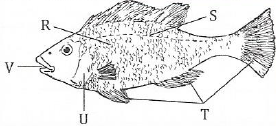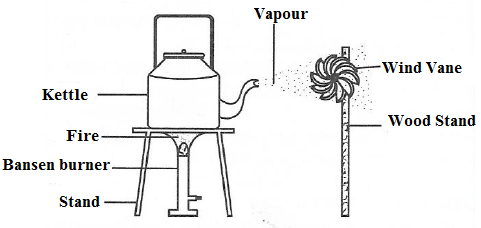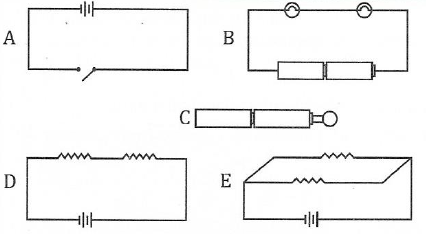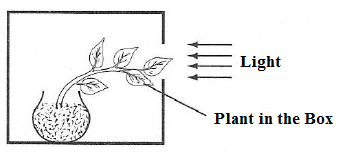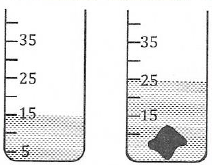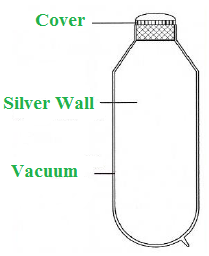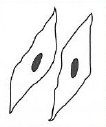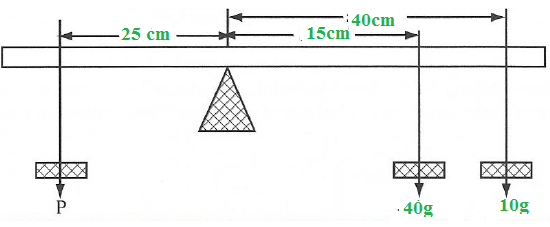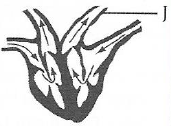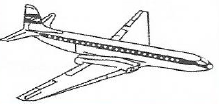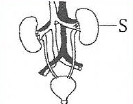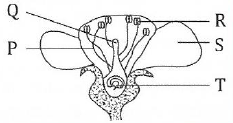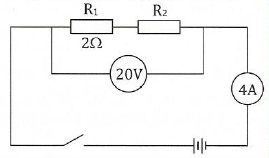UNITED REPUBLIC OF TANZANIA
NATIONAL EXAMINATIONS COUNCIL OF TANZANIA PRIMARY SCHOOL LEAVING EXAMINATION
05 SCIENCE AND TECHNOLOGY
Duration: 1:30 Hour Year: 2021
Instructions
1. This paper has sections A and B containing a total of forty-five (45) questions .
2. Answer all the questions in each section.
3. Read all the instructions in the special answer form (OMR).
4. Fill in all the required information in the OMR form.
5. Tick each digit of your test number in the space provided in the OMR form.
6. Tick the letter of the correct answer to question 1 to 40 in your given answer form. For example, if the correct answer is A cast a shadow as follows:

7. If you notice that the letter you have shaded is not the correct answer , delete the shadow carefully using a clean eraser before placing the shadow in the new letter.
8. Use the HB pencil only to answer questions 1 to 40, and the blue or black ink pen to answer questions 41 to 45.
9. Communication equipment and all unauthorized items are not required in the examination room.
SECTION A (Mark 40)
In questions 1 - 40 , select the correct answer and then tick the answer in the special answer form ( OMR ) provided.
1. The excretory system in the human body is made up of four main organs. Which organ is responsible for the release of carbon dioxide and water in the form of water vapour?
- Lungs
- Kidney
- Nephron
- Nose
- Acoustic nerve
2. An old man was seen staggering in the street after drinking too much alcohol. What part of the ear was affected by alcohol?
- Bracelets.
- Ear drum.
- Semicircular canals.
- Chochlea.
- Acoustic nerves.
3. Some people have trouble seeing at night. What are the causes of these problems?
- A
- B1
- B2
- D
- C
4. Mother was dizzy and weak. After examining him, the doctor found that he had anemia. What kind of food would you recommend?
- Foods with enough sugar.
- Foods rich in iron.
- Fatty foods.
- Carbohydrate foods only.
- Salty foods.
5. Your friend is having difficulty seeing the ball placed next to him. What kind of sunglasses would you advise him to use?
- Convex lens
- Concave lens
- Two lenses
- Large lens
- Small lens
6. My brother cut himself on the finger while he was peeling sweet potatoes. He bandaged the wound, but the bleeding continued for a long time. What was lacking in my brother's blood?
- white blood cells
- Platelets
- Plasma
- Minerals salts
- red blood cells
7. Farmers were educated by an agricultural expert to stop using agricultural methods that cause soil erosion. What method should those farmers not use?
- Planting trees in the field.
- Cultivation on terraces.
- Farming following contours.
- Farming on terraces.
- Burning farm remains to clean it.
8. Which group represents vertebrates?
- Snakes, Donkeys, Snails and Hyenas.
- Lizard, Butterfly, Zebra and Lion.
- Crocodile, Antelope, Elephant nå Butterfly.
- Deer, Crocodile, Hippopotamus and Giraffe.
- Snails, Crabs, Elephants and Zebras.
9. Your brother was amazed to see a skull mark on electric poles and containers for chemicals used in Toilets. What does the mark on those parts signify?
- Toxic or dangerous
- It catches fire
- It corrodes and burns
- It explodes
- It irritates
10. Grade five students did an experiment to make a simple circuit using dry cells, wires and bulbs. Which group managed to light the bulbs?
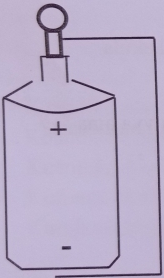 | 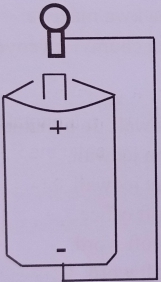 | 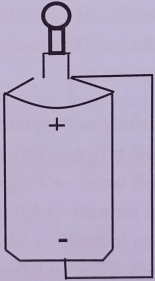 | 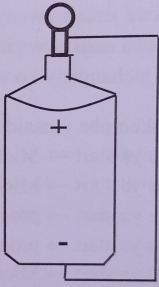 | 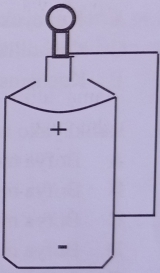 |
| A | B | C | D | E |
ll. A student witnessed a school building collapse from a thunderstorm. What do you suggest should be done on the premises so that such a problem does not occur in other buildings?
- Construct using bricks.
- It should be built with a thick wall.
- Have a lightning block wall.
- Connect it on earth wire.
- Erect lighting arrestor
12. A steel factory worker got metal particles in his eyes and needs help. What will you do to help him?
- Washing his face with clean water and soap.
- Using a magnet that will attract the particles.
- Using earplug to remove the particles.
- Use a clean cloth to wipe the inside of the eye.
- Bend him down so that the particles fall off.
13. John looked at the calm water and saw his face. What characteristic of light was being demonstrated?
- Travel
- Bending
- Penetration
- Reflection
- Digestion
14. What makes gasoline better than wood as a source of energy?
- It does not emit smoke when using.
- Provides oxygen gas.
- It emits carbon dioxide gas.
- It has no cost in production.
- It can be used in small quantities.
15. The plant absorbs water molecules from the soil through the roots to various parts. What method does the plant use to absorb water?
- Osmosis
- Diffusions
- Distribution
- Propagation
- Absorption
16. What action will lead to the formation of new matter?
- Melting sugar in water.
- Milk fermentation.
- The conversion of water to steam.
- Adding salt to food.
- Boil wax mixture with water.
17. Your friend has asked you to help him open excel program. What steps will you take?
- Click the start menu → Microsoft office → Program table.
- Click the start menu → Microsoft word → Program table.
- Click the start menu → program table → Microsoft office.
- Click the start menu → Y program table → Microsoft word.
- Click the start menu → Microsoft office → Microsoft word.
18. The Headmaster of Makuti Primary School wants to change the record keeping system from an attendance register system to an electronic system. What machine would you advise him to use?
- TV
- Computer
- Decorder
- System
- Router
19. The Science and Technology subject teacher wanted you to have a gmail email. What is the first step to getting an email?
- Visit the website address "www.gmail.com".
- Fill in all required information in gmail form.
- Fill in the phone number and date of birth in gmail form.
- Select the type of address you want to use in gmail.
- Visit the website "www.yahoo.com" and enter passwords correctly.
20. The media has reported that most radio stations in Magunga village use a small loop antenna. What are the disadvantages of using such antennas?
- Causes radio damage.
- It causes a loss of electrical energy.
- Causes damage to the speaker.
- They require high maintenance costs.
- They have wave interruption.
21. Why is it advisable to turn off the computer by following the correct steps?
- Protect against unexpected power outages.
- Avoid falling to the ground.
- Reduce the heat generated inside the computer.
- Protect against computer viruses.
- Avoid losing unsaved information.
22. The Kiswahili subject teacher sent the parents the results to the parents by e-mail but they did not receive the results. What is the most important thing that teacher did not take into account when sending emails?
- Enter the recipient's email address correctly.
- Write the title of the message.
- Enter the sender's email address correctly.
- Closing his account after use.
- Allowing the browser to remember its password.
23. Complex machines are designed using two or more simple machines. What is the significance of such a structure?
- Increase efficiency.
- B Increasing tension.
- C Increasing friction.
- D Increase motion.
- E Reduce friction.
24. Lever has three main parts that are arranged in a specific order. Which arrangement represents the third class levers?
- Effort, load and fulcrum.
- Fulcrum, effort and Load.
- Fulcrum, load and effort
- Load, fulcrum and effort.
- Effort, fulcrum and load.
25. What principle provides the link between mechanical benefits, load and effort in a rotary system?
| A. |  |
| B. |  |
| C. |  |
| D. |  |
| E. |  |
26. Grade Four students were instructed to bring complex machines to use to learn the components of those machines. What did they bring?
- Bicycle, sewing machine and weighing scales.
- Lock, bicycle and hammer.
- Kitchen, sewing machine and bicycle.
- Sewing machine, bicycle and bottle opener.
- weighing Scales, knob and bicycle.
27. What is the measure of resistance of electricity?
- Volt
- Ohm
- Voltimeter
- Amphere
- Ammeter
28. Which set contains acidic substances?
- Orange and ash.
- Lemon and ash.
- Ash and soda ash.
- Orange and lemon.
- Orange and soda.
29, One type of white, red, black, yellow and green cloth made of the same type of material was washed and hung in a sunny place. What color clothes will be the first to dry?
- White
- Red
- Black
- Yellow
- Green
30. Your friend's clothes caught fire caused by an oil explosion. What can you do to put out the fire?
- Take off all his clothes.
- Cover with a cold towel.
- Pouring water.
- cover with heavy blanket.
- Take her to the hospital.
31. A hunter was bitten by a snake at the leg. What initial help should he have given?
- Lay him on his back with his legs up.
- Take her to the hospital.
- Rub with ashes and salt.
- Tie up the upper part of where he was bitten.
- Rinse with clean water and soap.
32. Your grandfather has blurred vision. What foods would you advise her to use to help her with her problem?
- Bananas, oranges and nuts.
- Rice, pineapple and meat.
- Mangoes, carrots and leafy vegetables.
- Carrots, cassava and beans.
- Bread, bananas and cassava.
33. Students were forbidden to throw plastic top bottles after drinking water on school grounds to prevent pollution. What methods do you think should be used to prevent these bottles from polluting the environment?
- Burning them
- Return them to the factory
- Cut them into pieces and throw them away
- bury them in a hole
- keep them in store
34. Kaka Nikuu led the Grade 3 students to clean up the school environment to destroy mosquito breeding grounds. What important activities did they perform?
- Slashing and covering water holding places
- Sweeping and planting trees
- Planting flowera and slashing
- Removing cobwebs and mopping
- Dig up the filled holes and dig new ones
35. Which of the following do not relate to the health rules that everyone must follow to stay healthy?
- Eat a healthy diet
- Cleaning the environment
- Use clean and safe water
- Knowing various sports
- Relax and sleep
36. What diseases are caused by heredity in the genes from one generation to the next?
- Epilepsy and bilharzia
- Sickle cell and hemophilia
- Albinism and hepatitis
- Asthma and tuberculosis
- Hemophilia and gonorrhea
37. What kind of food should people who do hard work to carry luggage deserve to eat food rich in?
- Vitamins
- Oil
- Minerals
- Carbohydrate
- Protein
38. The digestive system in the human body is made up of different parts. What part absorbs water and minerals?
- Large intestine
- Gastrointestinal tract
- Stomach
- A gall bladder
- Rectum
39. Wood density is 20 kilograms per cubic meter. If the wood has a volume of 90 m3 , find the mass of wood.
- 110.0 kg
- 0.222 kg
- 4.5 kg
- 1800 kg
- 180.0 kg
40. A submarine is a type of vessel that can sink or float in water. If the submarine is in the water and it needs to float, what needs to be done?
- Water released and air filled into tanks.
- Water soaked and left the tanks empty without air.
- To add texture to the tanks, use a mucous membrane.
- Air is released into the tanks to reduce weight.
- Balancing the upthrust with the force of gravity on the submarine.
11. What are the basic necessities of life?
- Water, food and air.
- Vitamins, water and air.

- Proteins, carbohydrates and minerals.
- Water, air and fruit.
- Air, clothing and light.
12. Which part of the uterus for a woman works the same as the sperm duct in man?
- Ovary
- Uterus
- Cervix
- Falopia tube
- Virgina
13. Why is breast milk important to the baby?
- They have the same temperature as the mother's temperature.
- They contain nutrients and natural immune cells.
- They have the same temperature as boiled milk.
- They do not contain pathogens.
- They are available whenever needed.
14. What is bone function?
- Protect muscles.
- Making blood cells.
- Making salt.
- Protecting the blood system.
- Skin protection.
15. What are the main sources of protein '?
- Milk, meat and eggs.
- Milk, fish and vegetables.
- Milk, fish and fruit.
- Milk, meat and carrots.
- Milk, fish and corn.
16. Which of the following is not the function of saliva in the mouth?
- Protein digestion.
- Carbohydrate digestion.
- Making food wet.
- Make food soft.
- Facilitate food digestion
17. What is the cause of diabetes?
- Lack of thyroid hormone.
- Lack of adrenal hormone.
- Deffect in the thyroid gland.
- Deffect in pituitary gland.
- Deffect in the pancreas.
18. What is the function of cell membrane in a plant?
- Separate the living parts of a cell.
- Making the plant cells soft.
- Formation of plant cells.
- Prevent water loss from the plant.
- Facilitate photosynthesis .
19. In which group of animals does the bat belong?
- Mammalia
- Reptilia
- Bird
- Owl
- Amphibians
20. What advice does not apply to an AIDS victim ?
- Use the medication as prescribed by your doctor.
- Having AIDS-free partners.
- Accept yourself and educate others.
- Living with hope and self-care.
- Eat a complete diet and check your health regularly.
21. What is one way to reduce the risk of HIV infection ?
- Allocate special living areas for people living with HIV.
- Not sharing food with people living with HIV.
- Eat a complete diet and drink safe water.
- Changing habits and quitting unsafe sex.
- Exercise.
22. The following items conduct heat except
- wire
- Air
- Plastic
- Nail
- Water
23. In first class lever, where is the fulcrum located?
- Behind the effort.
- Beside the load.
- Infront of the effort.
- Same location as wheel.
- Between the load and effort.
24. Why are machines important in everyday life?
- Used to increase strength.
- Used to simplify tasks.
- Used to carry luggage.
- It is used to strengthen muscles.
- Relieves joint pain.
25. Which of the following items is a simple machine?
- Lever
- Winch
- Bicycles
- Car
- Motorcycles
26. How can you distinguish magnets from other types of materials?
- Magnets are more powerful than other materials.
- Magnets have the ability to attach objects to metal objects.
- The magnet is made of stainless steel.
- Magnets are heavier than other materials.
- The magnet is black.
27. If a machine carries a load of 60 newtons in an effort of 75 newtons, find the mechanical advantage?
- 450
- 4500
- 8
- 0.8
- 1.25
28. What device is used to measure current?
- Resistor
- Switch
- Ammeter
- Voltimeter
- Tester
29. When Hafizi dipped a piece of metal into a container filled with water, about 100 cm of water spilled. What information is correct about this scientific practice?
- The amount of water spilled is the same as what is left in the bucket.
- The volume of the stone is the same as the volume of spilled water.
- Spilled water is heavier than stone.
- A stone is thicker than water poured out.
- Spilled water and stone weigh the same.
30. What is the first aid for a nosebleeding person?
- By lying on the face.
- By placing a cloth behind the head.
- By placing a cloth with lukewarm water on the face.
- By placing a piece of cotton in the ear.
- By squeezing the nose for a few minutes.
31. What can be done to help a student who is vomiting?
- Give him salt water and sugar.
- Lay him down and call a nurse for treatment.
- Rest in the shade.
- Give him soft food.
- Calling his parents.
32. Where is the final step in conducting a scientific experiment?
- Set a goal.
- Write a conclusion.
- Identify the route.
- Preparing materials.
- Provide results.
33. What scientific method is used to arrive at the right conclussion?
- Prepare a questionnaire.
- Collect information.
- Conducting investigations.
- Answer the questions.
- Have a discussion.
34. Predictions about the outcome of problem expected to be investigated are known as
- experiment
- data
- results
- hypothesis
- conclusion
35. Examine Figure No. 1 and then answer the following question:
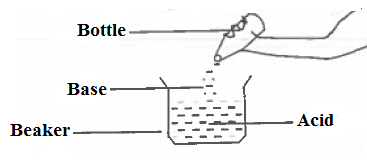 |
| Figure 1 |
What chemical will be in the pan after all the acids combine with the bases?
- Water and acid.
- soda ash.
- Salt and bases.
- Sugar and water.
- Salt and water.
36. Which characteristic refers to chemical change?
- The color of the newly formed substance is the same as that of the element.
- The new substance may not return to its original state.
- A new substance may combine with water to form acid.
- No new substance can be created.
- New substances can combine with acids to form salts.
37. Why does 'smoke' occur in the mouth when you breathe during cold weather?
- The temperature in the outside air is humid.
- The temperature in the outside air is low.
- Cold air has no moisture.
- External temperature is below 00C.
- The temperature in the indoor air is humid.
38. What substances cause metal to rust?
- Moisture and hydrogen.
- Carbon and oxygen.
- Neon and oxygen.
- Oxygen and moisture.
- Nitrogen and moisture.
39. What color occurs when lime water is mixed with the gas emitted during respiration?
- Yellow
- Blue
- Milky
- Brown
- Green
40. Which of the following equations is balanced?
- O2 + 2H 2 → 2H2O
- O2 + Mg → 2MgO
- 2Ca + O2 → CaO
- 2Ca + Cl 2 → 2CaCl 2
- H2O + O2 + 2H2
![]() 1. Which pair among these is concerned with reproduction in plants and animals correctly?.
1. Which pair among these is concerned with reproduction in plants and animals correctly?.
- Ovary in plants and sperms in animals

- Filament in plants and fallopian in
 animals
animals - Fruits in plants and testis in animals

- Flowers in plants and uterus in animals
- Seeds in plants and ovary in animals
2. In order for plants to continue surviving in their environment, they requires
- Air and soil
- Air and water
- Soil and fertilizer
- Moisture and air
- Temperature and air
3. Rice reproduces through ![]()
- Leaves
- Seeds
- Roots
- Suckers

- Branches
4, Which of the following groups of animals represents vertebrates?
- Snail, scorpion, crocodiles

- Snail, monitor lizard, snake and fish
- Monitor lizard, snake, spider and fish
- Snail, fish, frog and crocodile

- Lizard, snake, monitor lizard and
 crocodile
crocodile 
5. Caterpillar is one of the stages of ![]() growth of a
growth of a
- Bee
- Tsetse fly
- Jigger

- Cockroach
- Butterfly

6. Which of the following are characteristic of animals? ![]()
- They grow, they breath, they eat , they move

- They grow, they breath, they sleep, they move

- They grow, they breath, they move, they reproduce

- They grow, they see, they move, they reproduce

- They grow, Speak, they move, they reproduce

7. Electricity is caused by the flow of
- Electrons
- Protons

- Newtons

- Charges
- Atoms
8.Which of the following is a ![]() characteristic of a chameleon
characteristic of a chameleon ![]()
- It changes its sound
- It changes the type of food it eats

- It changes body colour
- It does not remove body waste
- It changes its movement
9. Which among the following is a mammal
- Snail
- Duck
- Bat
- lizard
- Frog

11.Which of the following gases is highly consumed in the atmosphere by plants?
- Carbon dioxide
- Oxygen
- Hydrogen
- Carbon monoxide
- Nitrogen

12.In order for water to be safe for ![]() drinking, it is supposed to be
drinking, it is supposed to be
- Boiled and covered
- Filtered and covered
- Boiled, filtered and stored
- Exposed the sun the whole day the whole day then to be cooled
- Put in a pot and covered
13.The following are essentials for health and growth of plants except
- Fertilizer from factories
- Water
- Carbon dioxide air

- Light from the sun
- Fertile soil
14.Air that is highly required by animals for their survival is ![]()
- Oxygen
- Carbon dioxide
- Nitrogen
- Hydrogen
- Carbon monoxide
15.A person who eats too fatty foods likely to get
- Beriberi
- Epilepsy
- Hypertension
- Diabetes
- Tuberculosis
16.A disease caused by defects of red blood cells is called
- Beriberi
- Sickle cell
- Cancer
- Diabetes
- Tuberculosis
17.Which among these gases diffuses fastest in a closed room with charcoal? ![]()
- Hydrogen
- Carbon monoxide
- Carbon dioxide
- Oxygen
- Nitrogen

18.What kind of glass can we use make our images look better?
- Convex mirror
- Concave mirror

- Flat mirror
- Convex lens

- Concave lens
19.Why is it important to wash frui&before eating?
- In order to get rid of poison
- Removing germs

- Removing sap
- Removing smell
- Removing salty taste
20.Which part in the digestive system concerned with protein digestion
- Mouth
- Small intestines
- Large intestines
- Oesophagus
- Stomach
21.What are the diseases caused by malnutrition?
- Marasmus, kwashiorkor, tickets
- Obesity, diabetes, coughing and dysentery

- Marasmus, kwashiorkor, paralysis and yellow fever

- Rickets, trachoma and marasmus
- Bilharzia, Malaria, tuberculosis and rickets
22.What does a person loose most when he has diarrhoea?
- Air
- Water
- Proteins
- Carbohydrates
- Vitamins
23.Which of the following nutrients are more suitable to children under five years?
- Carbohydrates, water and proteins
- Proteins, vitamins and salt
- Salt, proteins and water
- Vitamins, carbohydrates and water
- Carbohydrates, water and salt
24.Which among the following diseases is caused by bacteria?
- Pressure

- Tuberculosis
- HIV/ AIDS
- Bilharzia
- Diabetes

25.Which among the following groups of things are found in the fire engine?
-





 Fuel tank, carbon dioxide gas, and water
Fuel tank, carbon dioxide gas, and water - Water tank, carbon dioxide gas,and oxygen
- Fire brigade, water and carbon dioxide

- Water tank, a tank of coal and acetylene gas

- Water tank, a tank mixes of gases and big coats
26.Which of the following sentences gives a clear meaning of first aid?
- An immediate aid rendered to a person before taking him to hospital

- An immediate aid rendered to a person after reaching him to hospital

- An immediate aid rendered to a person by a health professional
- An aid rendered to a person whon has fainted
- An aid rendered to a person who has been bitten by a snake

27.What would you do if you happened to see clothes worn by your friend on fire?
- Applying him with oil

- Putting water on the wounds
- Covering him with a heavy blanket or a heavy cloth
- Blowing him with oxygen
- Undressing him the burnt clothes

28.Which of the following behaviours do not contribute to the spread of HIV AIDS?
- Sexual intercourse, drunkenness and breast feeding
- Sharing syringes and transfusion of contaminated blood
- Shaking hands, playing and eating together
- Poor education about HIV Aids and sex
- Prostitution and drug abuse
29.Why do people living with HIV AIDS need foods with a lot of nutrients?
- Their disease is a long term disease
- Their life is short so they need enough fats
- They frequently feel hungry
- They need to strengthen their body
 immunity
immunity - They need to be fat in order to avoid stigma from people
30.The rightest way to diagnose a person with HIV/ AIDS is by
- Testing Tuberculosis
- Testing the body temperature
- Testing the reduction of body weight
- Checking whether he has wounds in the mouth and face

- Testing the level of immunity in the body
31.Which action among these proves that air occupies space in the environment?
- Breathing through the mouth and nose

- Air bubbles from a bottle of water immersed in the water
- Long time coughing
- Moisture passing through the air
- Dropping a stone into an overflowing can .
32.Observe the diagram below (diagram 1) then answer the question that follows
(ii) (iii) (iv) (v)
Which among the following diagram shows the characteristic of light passing through water?
- ii
- iv
- iii
- i
- v
33. What will happen if a glass fun water and covered with a glass cover is turned upside down?
- Water will pour down
- The cover will drop down
- The glass will break
- Water will not spill
- Water will spill out
34. What is the main step that follows after discovering a problem in scientific investigation?
- Starting a deep investigation
- Formulating a hypothesis
- Preparing a procedure
- Preparing a scientific experiment
- Collecting information and data
35. Which is the correct procedure for ![]() writing a scientific report?
writing a scientific report? ![]()
- Objective, Procedure, materials. results, conclusion
- Materials, aim, procedure, results conclusion
- Procedure, aim, materials, conclusion, materials

- Procedure, aim, conclusion, results materials
- Aim, materials, procedure, results conclusion
36. How can iron be prevented from rusting?
- By applying ash
- By washing it using water
- By painting it
- By covering it with mud
- By covering it with sooth
37.Which among the following combinations is pure metal
- Chlorine, zinc, diamond and gold
- Iron, carbon, nitrogen and oxygen
- Oxygen, zinc, sulphur and chlorine
- Copper, iron, carbon monoxide and zinc
- Gold, zinc, aluminium and silver
38. Which of the following is an example of an element?
- Water
- Salt
- Vapour
- Sugar
- Carbon dioxide
39. Clouds falling down nearing the earth surface are known as
- Mist
- Salt
- Hydrogen
- Ice
- Rain
40. Observe the following diagram ![]() (diagram 2), then answer the following question
(diagram 2), then answer the following question
Letter P represents
- .Perpendicular light
- Reflected light
- Bent light
- Straight light
- Parallel light
Choose the correct answer and shade its letter beside each question number in the answer sheet provided.
1. Which of the following characteristics enable birds to fly in the air?
- Soft bones with features
- slim bones with a hollow inside
- Jointed bones

- have many bones
- wing bones are stronger
2.The main groups of living things are:-
- Plants and birds
- plants and lizards
- animals and leaves
- plant and animals
-
 animals and bacteria.
animals and bacteria.
3. Which of the following are types of seed, which are self dispersing?
- Coconut and cotton
- Cowpea and pigeon pea
-
 Cowpea and pawpaw
Cowpea and pawpaw - Mango and guava
- Orange and pigeon pea
4. Observe figure number 1, then choose the answer which has the correct arrangement of the indicated parts A -D
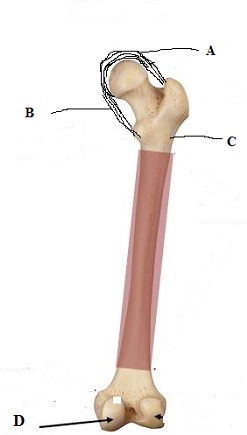
- Fibres, yellow bone marrow; red bone marrow, cartilage
- Red bone marrow, cartilage,
 yellow bone marrow, tendons
yellow bone marrow, tendons - Tendons, cartilage, red bone marrow, yellow bone •marrow
- Cartilage, tendons,yellow bone
 marrow, red bone marrow
marrow, red bone marrow - Yellow bone marrow, cartilage, tendons, red bone marrow
5. Observe figure number 2 and then answer the question which follows
- Reflection

- Penetration
- diversion
- converging
- dispersion

The device in figure 2 uses which characteristic of light?
6. Which diseases are prevented by ![]() vaccination?
vaccination?
- Measles and whooping cough
- bilharzias and malaria
- diarrhea and diphtheria
- AIDS and diabetes
- tuberculosis and chicken pox
7. What is an important thing pregnant woman should observe?
- Eat a lot of starch when she is approaching the expected date
- perform tough tasks order to be strong

- attend clinic and balanced diet

- sleep frequently
- use perfumed soaps always
![]() 8. A disease which results from respiratory system problem is
8. A disease which results from respiratory system problem is
- Asthma
- severe malaria
- fainting
- epilepsy
- diabetes

9.What will happen if the nervous system stops functioning?
- person will start shivering
- A person will feel weak
- A person will feel severe body pains

- there will be no communication in the body

- A person will start losing weight


10. One of the symptoms of kwashiorkor is
- the face resembles that of an old man
- White eyes and flue
- Neck gland enlargement
- Feeling cold and vomiting

- Big stomach and swelling of legs
11. Family planning methods which are more safe for the health of the mother are
- loops and injection
- natural methods

- injection and pills

- pills and condom
- condom and injection
13. A person who suffered an electric shock can be assisted by the use of
- legs
- iron bar
- dry wood
- hands
- wet wood
14. Two clean pieces of wood wrapped on the part of broken bone help to
- Prevent bleeding
- give heat to the wound
- support the broken part
- cure the broken part
- join the broken part
15. The gas used to extinguish fire is
- Hydrogen
- carbon dioxide
- nitrogen
- carbon
- Oxygen

16. HIV is not transmitted by
- Sexual intercourse
- sharing needle
- mosquito bite
- sharing razor blade
-
 blood transfusion
blood transfusion 
17.The relationship between sexually transmitted diseases and AIDS is that
- it is easy to get HIV if you
 have sexually transmitted diseases
have sexually transmitted diseases - Sexually transmitted diseases are the same as AIDS
- Drugs that cure sexually transmitted diseases
- are transmitted through sexual
 intercourse only
intercourse only - Sexually transmitted diseases
 and AIDS can be cured
and AIDS can be cured 

18. Which of the following sentences has the correct meaning of AIDS?
- Loss of body immunity
- high body immunity
- absence of body immunity
- deficiency of body immunity
- ability of body immunity

19. One of the methods of reducing HIV transmission is
- To reserve area for people
 living with HIV
living with HIV 
- To avoid sharing food utensils with people living
 with HIV
with HIV 
- To eat balanced diet and drink safe water
- to change behaviours and avoid unprotected sex
- To perform physical exercises

20. Why things thrown in the air fall down?
- Because of weight
- Because of force of friction
- because of force of air
- because of force of planets
- because of force of gravity
21. The relationship between magnet and electricity is
- The source of magnet is atomic energy
- Electricity resist magnetism
- Wherever there is magnet, there is electricity
- Wherever there is electricity, there is magnetism
- Magnetism resist electricity
23. The unit measure of force is
- Meter

- Kilogram
- Joule
- Kilometer
- Newton
24. Which instrument is used to measure a human body temperature?
- Thermometer
- galvanometer

- ammeter

- balance
- voltmeter
25. The following are source of electricity except
- Battery
- dry cell
- bulb
- generator
- magnet
26. What is the meaning of friction?
- . A force which produce
 motion
motion 
- A force which stops motion
- a force which accelerates motion

- a force opposite to motion
- an incident force
27.Which of the following lists of materials are in the group of complex machines?
- padlock, hammer and scissors
- wheelbarrow, razor blade and hammer
- a razor blade, padlock and a bicycle
- a sewing machine, pad Jock and a bicycle
- a razorblade, padlock and a wheelbarrow
28. Records of experiments are important because they are used to do the following except
- to compare the results of one experiment and others
- to give information of the experiment
- to be used as reference by other experts
- to enable other experiment s to be conducted

- to issue unconfirmed reports
30. In order to come up with hypothesis for a scientific experiment there must be
- An experiment
- some data
- report
- an apparatus
- a problem
31. In a lever, a load of 50kg was put 3 meters from the fulcrum. What is the distance required from the fulcrum to put an effort 20kg in order to balance the lever?
- 1.6 m
- 6.7 m
- 7.5 m
- 2.5 m
- 3 m
32. Blood deficiency is caused by
- Decrease of white cells, iron and vitamin
- Decrease of vitamin, protein and plasma
- Increase of water in the body, decrease of iron and protein
- Increase of platelets, iron
 and vitamin
and vitamin - Decrease of iron, vitamin, and protein.
33. Light rays travelling in a straight line strike on object and land on a mirror. What will be characteristic of the object, which appear in the mirror?
- the image will be upright
- the image will be coloured
- the image will be inverted
- the image will be the same as the object
- the image will be bigger than the object

34. A person whose diet lacks iodine ![]() is likely to get the diseases called
is likely to get the diseases called
- Beriberi
- goiter

- anaemia
- trachoma

- rickets

35. Elements found in the table salt are
- potassium and chlorine
- sodium and chlorine
- potassium and sodium
- sodium and sulphur
- calcium and magnesium


36. Zuzu dipped a stone in a bucket full of water. About 5000 cm3 of water spilled out. Which principle is correct about this scientific action?
- Water which spilled out is the same as the water that remained in the bucket.
- the volume of stone is the same as the volume of water which is spilled out
- water which spilled out is heavier than the stone
- the stone is heavier than the water which spilled out
- water spilled out and stone have the same mass

37. Night blindness is caused by lack of;
- vitamin K
- vitamin A
- vitamin E
- vitamin C
- vitamin B

38. Matter is made up of many ![]() small particles known as
small particles known as
- Valency
- compound
- element
- atom
- molecule
39. The amount of vapour in the air is measured by;
- barometer
- hydrometer
- anemometer
- ammeter
- thermometer
40. In order for iron to get rust, It requires humidity and;
- hydrogen
- carbon
- neon
- oxygen
- nitrogen
41. What are the results of oxidation of glucose in the blood?
- water, oxygen and heat water,
- heat and carbon monoxide energy,
- Water and carbon dioxide dew,
- heat and carbon dioxide

- oxygen, energy and sweat
42. In order to crystallize salt from water, the water must be
- frozen
- vapourized
- cooled
- boiled
- poured
43.The scientific experiment carried in order to verify the truth of the results another ongoing scientific experiment is known as
- special experiment
- reference experiment
- control experiment

- model experiment
- concluding experiment
44. The function of the bile in the digestive system is
- to kill germs

- to dissolve proteins
- to break down fats
- dissolve starch

- to absorb water
45. Which of the following food is mostly rich in starch?
- mango

- potatoes
- soya bean
- groundnut
- fish
46. Which organs are strengthened by calcium mineral and vitamin
- tongue and nose
- skin and stomach

- bones and teeth

- lungs and liver

- kidney and bladder
47. Which of the following is not part of blood?
- salts
- white cells
- platelets
- red cells
- plasma
48. When carbon dioxide combines chemically in a plant with water in the presence of light energy it gives
- carbon dioxide and water
- carbohydrate and oxygen

- carbohydrate and heat
- carbohydrate and chlorophyll

- carbohydrate and carbon hydroxide

![]()
![]() 49. The type of worms which spread elephantiasis is
49. The type of worms which spread elephantiasis is ![]() known as
known as
- Ascaris
- tape worms
- filarial

- millipede
- bacteria
![]() 50. The part of plant which absorb water is called
50. The part of plant which absorb water is called
- stem
- branch
- root
- flower
- Ieaf

Choose the correct answer then write letter of it beside the number of each question in the answer sheet.
1. In order a seed to germinate it needs the following things:
- Water, soil and air
- Rain, air and soil
- Moisture, soil and heat
- Water, air and heat
- Water, light and wind.
2. The intention of the insecta to shift from one flower to another is;
- To reproduce flowers

- To escape enemies
- To find honey

- To spread seeds

- To find smell
3. ![]()
![]() The action of a human being to faint is a result of absence of blood in the;
The action of a human being to faint is a result of absence of blood in the;
- Stomach
- Kidney
- Lungs
- Heart
- Brain
4. Two major types of machines are
- Hard and soft

- Simple and complex
- Grinding and decorticating
- Wheel and excel
- Excel and caterpillar
5. One way of removing out body excreta is
- Spitting
- Urinating
- Bathing
- Washing hands
- Giving out tears.
6. Unfertilized gamete is called?
- placenta
- ovum
- uterus
- ovary
- fallopian tube
7.Study the diagram below and answer the questions that follow;
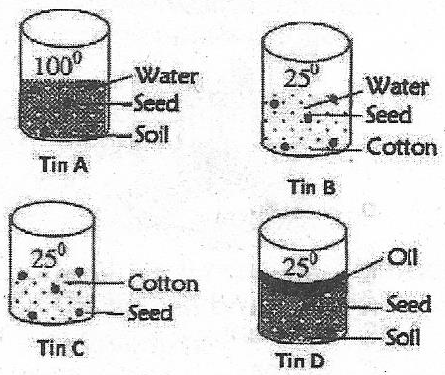
In which tin will the seeds germinate?
- Tin A
- Tin B
- Tin C
- Tin D
- Tin A and D
10. Transportation of food in the body is done by;
- heart
- blood
- muscles
- lungs
- water.
11. Study the following illustration careful and then answer the questions that follows;
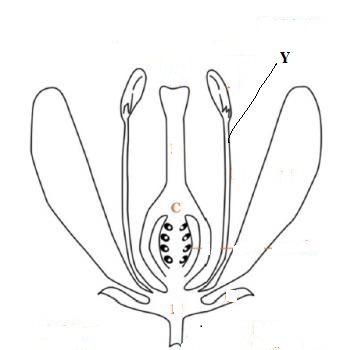
what is name of part Y
- petal
- filament
- stigma
- pistil
- ovary
12. Seeds of a plant store food at the;
- roots
- leaves
- stem
- cotyledon
- fruit
13. Which disease among the following is infected through sexual intercourse?
- polio
- cholera
- scurvy
- syphillis
- measles
14. 1f carnivorous are more than herbivorous, what will happen?
- grass will decrease
- grass will remain as before
- grass will dry
- grass will increase
- grass will be eaten
15. Which group among the following has body defending foods?
- fish and milk
- beans and ground nuts
- ugali and beans
- eggs and cabbage
- fruits and vegetables
16. the importance of hydrochloric acid in the stomach is;
- changing the state of alkalis in the stomach
- softening fats in the stomach
- adding sour in the stomach
- digesting glucose in the stomach
- killing germs that enter the stomach with food.
17. what is the difference between malaria and typhoid?
- malaria attacks blood vessels, typhoid attacks nerves
- malaria is caused by mosquitoes, typhoid is caused by flies.
- malaria is treated in four days while typhoid is treated in seven days
- malaria is caused by plasmodium, typhoid is caused by bacteria
- malaria is accompanied by head pains, typhoid is accompanied by back ache
18.Which of the following should be maintained?
- Using one cup for drinking water
- washing hands in one basin
- cooking vegetables and meat for a long time
- boiling and filtering drinking water
- swimming in a river not in a dam
19. Organs responsible for excretion in the body are.
- Kidney, liver and heart
- Liver, skin and kidney
- Lungs, heart and kidney
- Heart, kidney and skin
- Skin, liver and heart
20. Tsetse flies cause the disease of
- Typhoid

- Legs and mouths
- Sleeping sickness
- Smallpox
- Liver fever
21. We can defend ourselves from heart diseases by putting in ![]() mind the following:
mind the following:
- Eating food and doing physical exercises

- Doing physicai exercises and avoiding drinking liquor
- Eating salty food and drinking liquor.
- Doing physica: exercises and smoking
- Eating fatty foods and drinking liquor
23. In order to defend ourselves from malaria disease we should
- Swailow a combination of medicine

- Swallow herbal medicine
- Use protected mosquito nets
- Cover ourselves with large protected blanket

- Do physical exercises daily
24. Pancreatic gland produces a hormone which rectifies.
- Amount of blood
- B. Sugar in the body
- Giving out body wastes
- Appetite of eating
- Amount of oxygen
25.One of the functions of muscles in the human body is
- Movement

- Passing blood through them
- Passing water through them
- Passing air through them
- Strengthening the body.
26. Wnich among the following action should not be done to a person afflicted with muscles?
- Rubbing the affected place with a palm
- Rubbing by stressing till the muscles loosen
- Rubbing the muscles with a cold water cloth.

- Using chemicals that can loosen muscles.
- Lying the victim on their back and rubbing muscles with hot water.
27. ![]() A person who vomit and undergoes diarrhoea should be given
A person who vomit and undergoes diarrhoea should be given
- Acid, milk and water
- Milk, base and sugar
- Water, base and milk
- Salt, sugar and water
- Sugar, acid and base.
28. The first aid which should be given to a fainting person is,
- Providing them with oxygen
- Giving them fruit juice
- Lying them on backs and pressing their stomachs
- Giving them glucose water
- Giving them sugar, salt and orange juice.
29. The network of AIDS affected ![]() victims is widening because:
victims is widening because:
- Uses of condom and mobile phones has increased
- Advertisement about AIDS has been made better
- Unsafe sexual relationships have increased
- AIDS education is given to a few people

- People affected with AIDS viruses follow regulations of joining the network.
30. AIDS can spread by
- Greeting the AIDS patient by shaking hands
- Sleeping with the AIDS patient in one room
- Talking with the AIDS patient

- Sharing blood
- Washing clothes of AIDS victims
![]()
![]()
![]()
![]() 31.1n order to prevent new infections of AIDS, people are advised;
31.1n order to prevent new infections of AIDS, people are advised;
- To swallow pills and to do physical exercises.
- To be faithful and get rid cf unsafe sex.

- To prevent touching one ary other and avoiding co-operation with the victims
- Not eating together and exchanging clothes with the victims

- To be given vaccination of AIDS and TB
32. Which among the following causes a plastic bottle to shrink when the air inside it is pulled outside? ![]()
- Air pressure inside the bottle being bigger than outside the bottle

- Air pressure outside the battleis being bigger than inside the bottle

- Air pressure outside and inside the bottle being equal
- Air pressure inside the bottle being smaller than that pulling the air
- Air pressure outside the bottle being equal to the volume of air in the mouth
33. Very small parts of matter that makes pieces responsible in combination of chemical is known as;
- Molecules
- Electron
- Proton
- Atom
- Neutron
34. Bending of a ray of light is the result of the light that passes from;
- The North pole to the South pole

- One medium to another
- The North pole to the East
- The West to the East

- The North pole to the West 35.
35. Study illustration number 3 which shows the structure of an atom; ![]()
Which letter shows an electron?
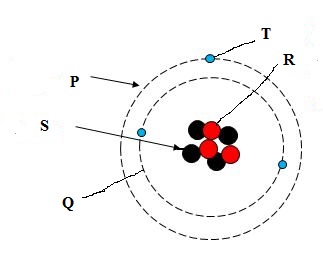
36. Friction of plastic items such as a comb at the hair gives out;
- Oxygen

- Electric charges
- Magnetism
- Stream
- Oil molecules
37. Which among the following is a symbol of a chlorine atom?
- K
- P
- Na
- Cl
- H
38. Carbon dioxide is used to extinguish fire because;
- It doesnt support fire burning
- It has more density than air
- It doesnt burn

- It absorbs heat
- It joins with oxygen.
![]()
39. Which of the following are the functions of a magnet?
- To make a magnetic field and lifting loads
- To produce electricity and to make a compass

- To be used in loud speakers
 and to make magnetic field
and to make magnetic field - To pull the North pole and production of electricity

- To show direction and to make speakers.
40. Find the distance of the load from the fulcrum in the lever ![]() that a load has 50grams, effort force of 100 Newtons and the effort arm is 40cm
that a load has 50grams, effort force of 100 Newtons and the effort arm is 40cm ![]()
- 75crn

- 1500cm
- 140cm
- 80crn

- 12.5cm
41. The two types of electric circuits are; ![]()
- indirect current and series
- Parallel and series
- Direct and parallel

- Direct current and series
- Direct current and parallel
42. Bones are made of which minerals?
- Sodium and calcium
- Calcium and oxygen
- Phosphorus-and calcium
- Sulphur and phosphorus

- Calcium and iron

43. When an acid reacts chemically with a base the result is the solution called;
- Salt and water
- Soda ash
- Salt and base
- Water and acid
- Salt and oxygen

44. If a machine with a load of kilograrn force go needs effort of kilogram 90 force 15, mechanical advantage is;
- 15
- 10
- 8
- 6
- 5
45. A magnet can attract things that have a nature of;
- Plastic
- Soil

- Minerals
- Paper
- Iron
46. The action of decaying animals excreta which is done by bacteria inside a pit in which there is no oxygen, causes;
- Extreme heat
- Biogas

- Concentrated acid
- Concentrated alkali

- Hydrogen
47. At which place is an image formed in the eye?
- Iris
- Lens
- Ciliary muscles
- film
- retina
48. In a torch the electric energy given out by a dry cell in converted into;
- Chemical energy
- Heat energy

- Mechanical energy
- Light energy
- Fire energy
49. What is the meaning of hypothesis in scientific investigation?
- Imaginary ideas

- Prediction of guessed result
- Prediction of experiment result

- Deep ideas
- Ideas made before investigation
50. One of the steps to be put in mind when preparing a scientific experiment is;
- To do investigation

- To prepare questionnaire
- To identify the problem
- To solve the problem
- To write a report
41. The crop shown on the photograph is;
- Cereal crop
- Cash crop
- Fruit crop
- Seasonal Crop
- Food Crop
42.Three regions in Tanzania where the crop is grown mostly are;
- Arusha. Dodoma and Kilimanjaro

- Tanga, Morogoro and Kilimanjaro
- Iringa, Mbeya and Rukwa
- Dodoma,Rukwa and Tabora

- Rukwa, Kagera and Kilimanjaro
![]() 43. Verbal communication is done through;
43. Verbal communication is done through;
- Touching and writing alone
- Phones, television and radio
- Writing and television

- Touching and drawing alone
- Sign language, touching and radio

44. ![]()
![]()
![]() Which ones among the following are the negative consequences of modern communication means;
Which ones among the following are the negative consequences of modern communication means;
- Moral degeneration
- Accessing information

- Bringing development
- Educating the society
- Maintaining unity
45. Two types of trade are
- Credit and paying trade
- Credit and exchanging trade
- Capital and money trade
- Money and capital market trade

- International and domestic trade
46. What does Tanzania gain from increasing international trade?
- Increase in building
- Reducing the number of internal entrepreneurs
- Increasing in professions
- Reduction of trade contracts
- Increasing in foreign change.
47. What are the major types of transport in Tanzania
- Water, rivers and air
- Land., water and air
- Oceans, land and air
- Land, water and lake
- River, lakes and oceans
48. Which group among the lowing represents the source of gaseous pollutants?
- Laboratories, vegetables canes
- Nylon bags, broken bottles and unpleasant smell
- Laboratories, industries and vehicles
- Vehicles domestic wastes and industries
- Laboratories, domestic wastes and industries.
49. The Tanzania society can control waste disposals through;
- Smashing wastes carelessly
- Undertaking modern farming
- Smashing wastes in channels
- Using plastic bags

- Disseminating environmetal education

50. Countries that use stored rain water for draining the land clude
- USA and India
- Tanzania and India
- India and Kenya
- Kenya and Uganda
- China and USA
Choose the correct answer and write its letter.
1. Which of the following groups represent characteristics of living organisms?
- Dying, feeding and seeing
- Dying, reproducing and
 changing colour
changing colour - To respire, to respond and hearing
- To respire, to reproduce and to walk
- To move, to respire
 reproduce
reproduce 
2. Why hybrid ![]() species of animals and plants are better?
species of animals and plants are better?
- They clongate and do not
 need fertilizers
need fertilizers - They produce quality product and resist diseases
- They mature early and yield
 strong production
strong production - They do not need nutrients
 and resist diseases
and resist diseases - They mature early and do
 not need medicine.
not need medicine.
3. Which of the following groups are the characteristics used to identify animals that belong to reptiles?
- Laying eggs, cold blood living in water
- Laying eggs, living in water and terrestrial life
- laying eggs, warm blood and terrestrial life
- laying eggs, cold blood and respire by using fins
- laying eggs, respire using skin and living in water.
4. Blood takes in oxygen and gives out carbon dioxide through;
- air Sacs
- walls of lungs
- epiglotis
- capillaries
- Nose
5. The absence of chlorophyll in a plant may lead to;
- lack of iodine in plants
- failure of plants to synthesize food
- drying of the plant leaves
- plant leaves becoming yellow
- shading off the plant leaves.
6. Phototropism is a process whereby plant grows towards,
- light
- gravitational force
- water
- darkness
- chemicals
7.Part of a cell responsible for coordinating all cell activities is called;
- cytoplasm
- vacuole
- chloroplast
- cell membrane
- nucleus
8. The following figure shows living things which are poisonous, except;
9. The action of a plant transporting water from roots to the leaves is called;
- osmosis
- diffusion
- push
- pressure
- movement
10. Which of the following glands control the activity of other glands;
- pancrease
- pituitary
- thyroid
- adrenaline
- parathyroid
11. The femaole part of a flower which is responsible for reproduction
- stamen
- style
- ovary
- petal
- sepal
12. The difference betwen a fruit and a seed is.......
- a seed has a fruit
- a fruit can germinate
- fruit has two cotyledones
- seed can germinate
- seeds are not eaten
13. Things which are important for health and life are
- Playing football, bathing, washing clothes, over
 feeding
feeding - Eating, being clean, resting, playing
- Doing exercises, eating balanced meal, resting and being clean

- Eating eggs, recreation, sleeping, cleaning the environment
- Taking bath, eating, sleeping
14. Food rich in carbohydrate enable the body to
- Withstand diseases
- Become warm
- Grow rapidly
- Become energetic
- Become soft
15. Which of the following are non ![]() infectious diseases?
infectious diseases?
- Malaria, colds and diabetes.
- Asthma, diabetes cholera
- Bilharzias, hookworm
 rickets
rickets - Diarrhea, typhoid fever and asthma
- Asthma, epilepsy and fowl pox.

16. Why is it important to rest after work?
- The body cools

- The body experience
- The body regain energy
- The body to perform activities
- The person is allowed to sleep
17. Diseases which can prevented by vaccination are
- Asthma, whooping cough, malaria and cholera
- Tuberculosis, asthma and measles
- Measles, diphtheria,
 tuberculosis and whooping
tuberculosis and whooping  cough
cough 
- Malaria, measles, tuberculosis and cholera
- Diphtheria, tuberculosis, AIDS and measles.
18. Residents of Mlalo eat beans, meat and rice. For better health, they need to add ![]()
- Fish

- Green vegetables
- Chicken
- Bread
- Cow pea
19. Which among the following can be reduced from the body through participating in sports ![]() and exercises?
and exercises?
- Sugar

- Proteins

- Poisons

- Dirtiness
- Fats
20. Which of the following is not a proper way of preventing malaria disease?
- Cutting grasses
- Covering water swamp
- Using mosquito nets
- Spraying insecticides
- Burning wastes
21. Exercise is one of the methods of reducing
- Vomiting
- Fainting

- Muscle contraction
- Diarrhoea
- Nose bleeding
22.A child with rickets lacks vitamin
- K
- D
- A
- B
- C
23.Lack of vitamin B lead to a disease called
- Meningitis
- ulcers
- Measles
- Trachoma

- Beriberi
24.One of the advantages protein foods in our bodies is
- To protect against diseases
- For the growth and repair cells
- To provide energy
- To increase weight
- To provide heat
25.What is first aid?
- An emergency service given to a patient by a doctor.
- Prior service given to a patient before being sent to hospital

- A service given for a person
 suffering from fire wound
suffering from fire wound - A service given to a person with bitten by snake
- A service given to a person with broken bones.

26.One of the important aid given to a person who burnt by fire.
- Pouring water
- Covering with clothes
- POURING acid
- covering with blanket
- smearing honey.
27. One of the effects of applying oil on a wound caused by fire is to;
- increase temperature in the wound
- increase pain in the wound
- allow air to penetrate
- causes germs to enter the wound
- increases swollen blisters
28.Which of the following statements is correct about HIV and AIDS?
- Having HIV is the same as having AIDS
- The source of HIV and AIDS is veneral diseases
- It is easy to prevent AIDS than HIV

- Avoiding transmission of HIV will also avoid AIDS
- A person with HIV has no white blood cells
29. One of the germs which destroys the white blood cells is
- Bacteria
- HIV
- Plasmodium
- Amoeba
- Fungus
30.Which of the following is common to„the spread of HIV in the society?
- Sharing of needles, toothbrushes, blood and unsafe sex

- Video cassettes, songs, music and plays
- Television, newspapers and leaflets concerning HIV
- Condoms, health experts, seminars and AIDS institutions
- Circumcision of men and women
31.Which blood cells are attacked by HIV?
- Platelate cells
- White blood cells
- Red blood cells
- Hemoglobin

- Plasma
32.One can get sugar from sugar cane solution by
- Boiling and filtration
- Boiling and cooling
- Cooling and freezing

- Boiling up to vaporization
- Putting on sunlight

33.When observing a person cutting a tree from a distance you can see an axe hitting the tree before hearing the sound.
This shows that;
- Light travels in a straight
- Sound travels slower than light
- Light travels slower than
 sound
sound 
- Sound travels faster than light
- Sound travels on straight line
34.What is the difference between ice and water?
- Water is heavier than ice
- Water is more cohesive than ice
- Water is less coloured than ice
- Water occupies space but ice does not

- Ice is soft than water
35.Change of matter that does not lead to change in mass is known Chemical change
- Chemical change
- Physical change
- Change in density

- Change of state
- Natural change
36.Dissolved ash from lemon leaves changes litmus paper from;
- Blue to white
- Red to blue
- Blue to red
- Blue to green

- Red to yellow
37.A mixture of different known as
- Oxygen
- Hydrogen
- Air
- Nitrogen

- Mater
![]() 38. Which of the following chemical change?
38. Which of the following chemical change?
- Decomposition of garbage

- Souring of milk
- Burning of charcoal
- Dissolution of sugar
- Rusting of iron
39. ![]() Which of the following pairs is correct about lens?
Which of the following pairs is correct about lens?
- Convex lens diverges light rays
-
 Concave lens correct long sightedness
Concave lens correct long sightedness 
- Convex lens correct sightedness

- Concave lens correct short sightedness

- Concave lens converge light rays
40.The function of pulleys in our daily life is
- To lift heavy load
- to open bottle tops
- to wrap objects
- to reduce slope
- to simplify firewood from chopping
41.Observe the signs in the following figure and name them according to their arrangement from;left side;
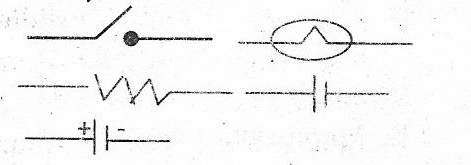
- Capacitor, dynamo, dry cell,
 switch, battery
switch, battery 
- Switch, bulb, resistor, capacitor, dry cell
- Bulb, capacitor, dry cell, resistor, battery

- Resistor, bulb, switch, dry cell, capacitor
- Switch, resistor, bulb; dray cell, capacitor.
42.Which device is used to magnify the image of very small objects?
- Telescope
- Microscope

- Periscope
- Prism

- Lens
43.An electric current of 0.8 amperes is passing through a wire which has a resistance of 24 ohms. What is the voltage of the electricity in the circuit?
- 30
- 192
- 24
- 19
- 19.2
44. Which among the following does not conduct electricity?
- rubber
- tin
- copper
- iron
- mercury
45. A device which is made of magnet and used by sea men in order to locate direction while travelling in the sea is known as
- Bell
- telephone
- horn
- compass
- speaker
46. The following symbols are used in an electric circuit.Which symbol represents a resistor?
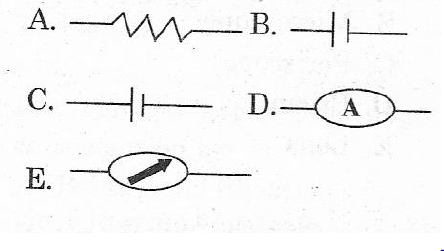
47. The correct formula of finding the work done is;
- Work done =Force x Weight
- Work done =Distance/Time
- Work done =Force/Time
- Work done =Force x Distance
- Work done =Distance/Force
48.Our images can be seen clearly when we use
- Concave mirror
- Convex mirror
- Plane mirror
- Concave lens
- Convex lens
49.It is important to keep records of the experiment done in order to
- Use it as reference
- Publish the efficiency of the
 person who did the experiment
person who did the experiment - Draw the table of results
- Be used to correct different data

- Facilitate development

50.The researched and analysed data can be represented by
- Graph
- Report
- Calculations

- Interpretation
- Drawing
THE UNITED REPUBLIC OF TANZANIA NATIONAL EXAMINATIONS COUNCIL
PRIMARY SCHOOL LEAVING EXAMINATION
05 E SCIENCE
Time: 1:30 Hours Wednesday, 10th September 2014 a.m
Instructions
- This paper consists of fifty (50)questions.
- Answer allthe questions.
- Read all the given instructions in the special answer sheet (OMR)and fill in allthe required information.
- Write your Examination Numberand then shade the digitsof the number in therespective place in your answer sheet.
- Shadethe letter of the correct answer for each question in the answer sheet provided, for example, if the correct answer is A shade as follows:
- If you have to change your answer, you must rub out the shading very neatlybefore shading the new one. Use a clean rubber.
- Use HB pencilonly.
- Cellular phones are not allowedin the examination room
Choose the correct answer and shade its letter beside each question in the answer sheet provided.
1. Which of the following diseases can be spread by houseflies and cockroaches?
- Chicken pox
- Diarrhoea
- Whooping cough
- Malnutrition
- Typhoid.
2. Which of the following is not found in the blood system?
- Bronchiole
- Valve
- Auricle
- Capillary
- Artery.
3. Which of the following should be considered before attending a person suffering from AIDS?
- Wear clean clothes
- Wash yourself with soap
- Wear gloves
- Pray
- Allow him/her to rest.
4. Which of the following is a characteristic of clean and safe water?
- Fetched from wells
- Stored and cooled in a water pot
- Filtered and stored in clean container
- Boiled, filtered and stored in clean container
- Without a lot of soda ash.
5. Which of the following diseases does not have a vaccine?
- Tuberculosis
- Tetanus
- Measles
- Whooping cough
- Trachoma.
6. The gas used by plants to manufacture proteins is
- carbon dioxide
- hydrogen
- oxygen
- nitrogen
- natural gas.
7. The amount of water lost by plants increase due to the presence of whichcondition in the environment?
- Heat and water vapour
- Water vapour and light
- Wind and sun rays
- Clouds and wind
- Water vapour and wind .
8. People are likely to cause soil erosion if they do one of the following:
- Cut down trees
- Add manure to the soils
- Plant grass
- Make terraces on sloppy ground
- Plant trees.
9. Agriculture, livestock keeping and mining are activities done by human beingsand all depend on
- rivers
- springs
- land
- irrigation
- wind.
10. A chameleon usually changes its colour in order to
- search for food
- breath
- reproduce
- observe enemies
- . Protect itself
11. How many stages are there in the growth of a cockroach?
- Two
- Three
- Four
- Five
- Six.
12. Which of the following does not have vertebral column?
- Spider
- Bat
- Cat
- Man
- Chicken.
13. One of the functions of the muscles in the body is to
- prevent bleeding
- cause various movements
- produce red blood cells
- hold the teeth in place
- E transport blood in the body.
14.Human bones are joined in order to
- prevent breakage
- make them of the same size
- enable them to bend easily
- make the shape of the body
- enable them to straighten.
15. Which of the following bend when passing from one medium to another?
- Rainbow
- Parallel lines
- Light ray
- Lens focus
- A ray and lens focus.
16. In the light spectrum, the colour which bends earlier than others is
- red
- yellow
- indigo
- blue
- violet.
17. Study Figure 1 which shows the internal part of a bean seed.
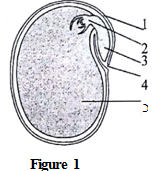
Which part is responsible for protecting the seed from harmful insects or changes
in temperature?
- 2
- 3
- 5
- 4
- 1.
18. The sky looks blue because
- air and water are bluish
- red colour is dispersed more than blue colour
- vision power decreases
- blue colour is dispersed more than other colours
- during sunset, the sun appears yellowish.
19. Which of the following items does not use magnet?
- Loud speaker
- Telephone
- Radio
- Mobile phone
- Iron.
20. The unit of work is
- Kilogram
- Newton
- Tonne
- Joule
- Gram.
21. In the normal procedure, the first stage to be followed when conducting a
scientific experiment is
- to start an experiment
- data collection
- problem identification
- data analysis
- interpretation of results.
22. The third stage in a scientific experiment is
- data analysis
- interpretation of results
- preparation and starting the experiment
- data collection
- problem identification.
23. Bahati put a red litmus paper in an unknown chemical compound. The colour ofthe litmus paper changed to blue. This show that the chemical compound had
- acid
- ash
- water
- fat
- spirit.
25. What will happen if NORTH and NORTH magnetic poles approach each other?
- They will strongly attract each other
- They will attract each other towards one direction
- They will repel
- Nothing will happen
- They will break.
26. PQ is a ruler whose length is half a metre. A load of 20 gm is placed at P adistance of 0.1 m from the fulcrum. If a load is placed at Q a distance of 0.4 mfrom the fulcrum, what will be the weight of M when the rule is balancing?
- 4g
- 10g
- 5g
- 2.5g
- 25g.
27. The concept of reflection of light is manifested in one of the following things:
- Microscope
- Television
- Watch
- Bulb
- Spectacles.
28. Study Figure 2 which shows an electric circuit having bulbs connected in a parallel form and answer the question that follows.

What will happen when bulb 2 blows? Bulb number
- 3 only will remain alight
- 1 and 3 will remain alight
- 1only will remain alight
- 1 and 3 will blow
- 3 will blow.
29. Presence of living organisms, water and air is a characteristic of which of thefollowing planets?
- Mars
- Jupiter
- Venus
- Earth
- Saturn.
30. The earths axis is inclined at which degrees?
- 60
- 181/2
- 32 1/2
- 251/2
- 231/2.
31. Which of the following revolves around the earth from west to east?
- Sun
- Star
- Moon
- Meteor
- E Planet.
32. A person having swollen neck gland (goitre) has a deficiency of which mineralsalt?
- Calcium
- Iodine
- Potassium
- Phosphorus
- Limestone.
33. Carefully observe Figure 3 and answer the question that follows:
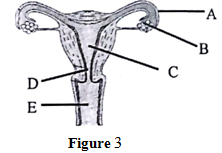
Which letter in Figure 3 represents the uterus?
- C
- D
- E
- A
- B.
34. One of the functions of the bones is to manufacture
- blood platelets
- blood plasma
- white blood cells
- red blood cells
- blood clotting cells
35.Uhuruhas a problemof having broken teeth and weak legs. What type of foodnutrients wouldyouadvise him to eat in order to solve the problem?
- Iron minerals
- Phosphorus minerals
- Calcium minerals
- Iodine minerals
- Vitamin K.
36. WhenAhadiwas asked a science question on solar eclipse, he thought for a whilebefore giving the correct response to the teacher. Which part of the brain did he use to answer the question?
- The front brain
- The hind brain
- The mid brain
- The front and hind brain
- The mid and hind brain.
37.The function of thespinal cord in thehuman nervoussystem is to
- deal with involuntary actions
- deal with voluntary actions
- Ccoordinate movement of the body
- maintain the shape of the body
- transport impulses to thecentral nervous system.
38. High tide and low tide in oceans and great lakes is caused by
- revolution of the earth around the sun
- rotation of the earth on its axis
- moon eclipse
- solar eclipse
- attraction force between the earth and the moon.
39. Under normal circumstances. rust is the result of a chemical reaction between
- copper, water and oxygen
- sodium_water and oxygen
- calcium, water and oxygen
- iron, oxygen and water
- water, oxygen and potassium.
40. Vegetables and fruits help in the formation of
- red blood cells
- white blood cells
- blood platelets
- blood plasma
- bone marrow.
41. The following methods can be used for food preservation except
- baking
- using honey
- Drying
- Salting
- Using water.
42. The following are types of food nutrients except
- mineral salts
- vitamins
- water
- Protein
- Carbohydrates
43. Which of the following foods canbe preservedby deep freezing?
- Fruits and vegetables
- Vegetables and meat
- Fish and fruit
- Meat and fish
- Meat and grain.
44. The deficiency disease caused by lack of iron in the diet is
- rickets
- kwashiorkor
- anaemia
- marasmus
- beriberi.
45. Carefully observe the foods represented in Figure 4 and then answer the question that follows.
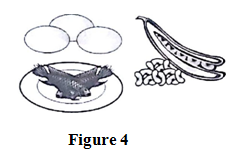
The function of the foods shown in Figure 4 is to
- build up the body
- give energy to the body
- protect the body
- generate heat to the body
- build up bones.
46. A fish which is in the water seems to be at the surface of the water while it isactually deep in the water because
- the fish is not stationary in the water
- the water is calm and clean
- the depth of water is reduced by the light rays
- fish scales make it appear big
- light rays are refracted in the water.
47. The correct food chain is
- eagle
 grass
grass  leopard
leopard  goat
goat - grass
 eagle
eagle  leopard
leopard  goat
goat - leopard
 eagle
eagle  grass
grass  goat
goat - grass
 goat
goat  leopard
leopard  eagle
eagle - eagle
 leopard
leopard  goat
goat  grass.
grass.
48. The three main parts of the circulatory system are
- arteries, veins and capillaries
- blood, heart and lungs
- blood, blood vessels and heart
- blood vessels, heart and valves
- heart, aorta and arteries.
49. Man uses the following sensory organs when doing scientific investigation:
- Tongue, eyes, nose, skin, ears
- Brain, nose, eyes, sensory nerves
- Brain, nose, ears, eyes, skin
- Brain, tongue, eyes, skin, ears
- Eyes, skin, ears, sensory nerves.
50. Which of the following hormones when insufficient cause defect in female reproductive system?
- Pituitary and insulin
- Estrogen and progesterone
- Thyroxine and pituitary
- Estrogen and insulin
- Thyroxine and estrogen.
THE UNITED REPUBLIC OF TANZANIA NATIONAL EXAMINATIONS COUNCIL
PRIMARY SCHOOL LEAVING EXAMINATION
05E SCIENCE
Time: 1:30 Hours Wednesday, 11th September 2013 a.m.
Instructions
- This paper consists of fifty (50) questions.
- Answer all the questions.
- Read all the given instructions in the special answer sheet (OMR)and fill in all therequired information.
- Write your Examination Number and then shade the digitsof the number in the respective place in your answer sheet.
- Shade the letter of the correct answer for each question in the answer sheet provided, forexample, if the correct answer is A shade as follows:
- If you have to change your answer, you must rub out the shading very neatly beforeshading the new one. Use a clean rubber.
- Use HE pencil only.
- Cellular phones are not allowed in the examination room.
Choose the correct answer andshade its letter beside each question in the answer sheetprovided.
1. Which among the following body parts are responsible for excreting waste products?
- Skin and kidney
- Stomach and kidney
- Pancreas and liver
- Liver and gland
- Lungs and heart.
2. Which of the following is a classification of animals with back bone?
- Snails, lizard and monitor lizard
- Tick, grasshopper and tsetse fly
- Toad, crocodile and ants
- Hen, bat and duck
- Snake, grasshopper and goat.
3. If rivers and dams get dry, which of the following living things will be mostly affected?
- Frogs
- Fish
- Crocodiles
- Mosquitoes
- Snakes.
4. is a dicotyledonous plant.
- Sugarcane
- Maize
- Rice
- Millet
- Groundnut.
5. Which part of the flower receives the male gametes?
- Stigma
- Style
- Testa
- Ovule
- Petal.
6. The relationship between living things and non living things in the environment is called
- interdependence
- food web
- ecology
- food chain
- balance of nature.
7. Which of the following living things use chlorophyll to manufacture their food?
- Insects
- Plants
- Animals
- Viruses
- Birds.
8. The gland responsible for controlling body growth and protecting the body against diseases is called
- Pancreas
- Adrenaline
- Pituitary
- Thyroid
- Gonad.
9.Animals which are adapted to living in water and terrestrial environment belong to a group of
- birds
- amphibians
- reptiles
- fish
- mammals.
10. Clean and safe water refers to water which
- has no color
- is cooled in the pot
- is obtained from the tap
- is obtained from the well
- has been boiled and filtered.
11. Cholera is a dangerous disease to human beings because
- it is spread by air
- it occurs during rainy season only
- it makes the body lose a lot of water
- it has no cure and cannot be prevented
- its real cause is not known.
12. A standard six student breath air into a test tube containing a clear solution, then he/she shook the test tube. After shaking the test tube, the colour of the solution became white.Which chemical was in the clear solution?
- Hydrochloric acid
- Sulphur
- Sulphuric acid
- Hydrogen
- Calcium hydroxide.
14. What is the function of haemoglobin in the red blood cells?
- To fight against bacteria
- To transport oxygen in the body
- To transport body waste products
- To carry digestive enzymes
- To distribute information in the body.
15. For the proper growth of bones and teeth, the child requires
- calcium, sodium and iron
- starch, fats and protein
- vitamin A, starch and fruits
- vitamin A, calcium and phosphorus
- eggs, fruits and starch.
16. The disease caused by bacteria known as bacilli which attacks human lungs is known as
- whooping cough
- measles
- bilharzias
- poliomyelitis
- tuberculosis.
17. Which of the following are communicable diseases?
- Measles, poliomyelitis and whooping cough
- Tuberculosis, diabetes and cancer
- Measles, elephantiasis and AIDS
- Whooping cough, asthma and severe cough
- Measles, malaria and diabetes.
18. The chemical used to identify the presence of starch is known as
- base
- acid
- spirit
- iodine
- salt.
19. Although animals inhale oxygen and exhale carbon dioxide, neither oxygen decrease norcarbon dioxide increase is significantly felt in the atmosphere because
- there is plenty of oxygen in the atmosphere
- carbon dioxide is changed into oxygen
- plants use carbon dioxide and release oxygen
- carbon dioxide affects ozone layer
- oxygen and carbon dioxide are regulated by ozone.
20. What is the importance of food substances rich in fats in the body?
- To build thebody
- To protect the body
- To prevent diseases
- To provide energy to the body
- To provide heat to the body.
21. Foods which cause the growth of animal bodies are called
- carbohydrates
- proteins
- vitamins
- fats
- minerals.
22. What is the objective of having first aid?
- To lower treatment expenses
- To save lives of sick people
- To reduce the number of medical doctors.
- To show mastery of treatment skills
- To simplify treatment
23. Which of the following first aid is given to a person with muscle pull?
- To do physical exercises
- To take a bed rest
- To wrap the muscle with a bandage
- To take pain killers
- To massage the muscle slowly.
24. A person who is suffering from diarrhea and vomiting looses
- water and blood
- sugar and salt
- water and salt
- salt and protein
- salt and blood.
25.The following instrument is not essential in the first aid kit.
- Razor blade
- Thermometer
- Scissors
- Spoon
- Forceps.
26.Which of the following diseases can be prevented by vaccination?
- Tetanus and malaria
- Elephantiasis and leprosy
- Tetanus and rabies
- Malaria and tuberculosis
- Cholera and leprosy.
27. Swollen legs, eating too much but always feeling hungry are symptoms of
- typhoid
- elephantiasis
- kwashiorkor
- worms
- diabetes.
28.Jack, screw, pair of scissors and chisel are types of simple machines known as
- Complex
- Levers
- Axle
- Roller
- Pulley.
29.Observe the following balanced chemical equation and answer the question that follows:
Base + Acid Y + Water
Which chemical is represented by letter Y?
- Alkali
- Oxygen
- Carbonate
- Salt
- Hydrogen.
30. Which among the following actions lead to formation of new matter?
- Melting of ice
- Filtration of dirty water
- Evaporation of water
- Dissolution of sugar
- Fermentation of milk.
31. What are the consequences of not protecting water sources?
- Death of animals and plants
- The nation will lose its manpower
- Fish breeding areas will disappear
- Seasonal rains will decrease
- Irrigation trenches will not be used.
32. The process of transporting dissolved salts in plants is known as
- absorption
- sucking
- diffusion
- osmosis
- photosynthesis.
33. The compound formed when two atoms of hydrogen chemically combine with one atomof oxygen is
- salt
- acid
- water
- base
- gas.
34. The gas which supports combustion is
- oxygen
- nitrogen
- hydrogen
- ozone
- carbon dioxide.
35. The type of water which turn its color to milky when mixed with soap is known as
- light water
- dirty water
- soft water
- heavy water
- hard water.
36. Echo refers to sound which is
- refracted
- absorbed
- heard
- reflected
- recorded.
37. Why is the voice of radio and television broadcasters not heard outside the broadcasting rooms through the walls?
- The walls are painted with sound absorbers
- The walls are constructed with sound absorbers
- The walls are painted with sound reflectors
- The walls reflect absorbed sound
- The walls refract sound.
38. The amount of current in an electric circuit is measured by
- rectifier
- resistor
- transformer
- voltmeter
- ammeter.
39. Figure 1 represents the action of magnetization
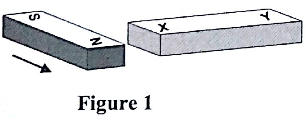
If the north pole of the magnet (N) is used to magnetize X pole of an iron bar which has poles X--Y, what will be the magnetic pole of Y in the iron bar?
- South
- East
- North
- West
- Central.
40. Which of the following colors is capable of reflecting light rays but not absorbing them?
- Black
- White
- Yellow
- Blue
- Green.
41.Which class of levers does the rope and hook in a fishing device belong?
- Second
- First
- Fifth
- Fourth
- Third.
42. Study the electric circuit in Figure 2 and answer the question that follows.
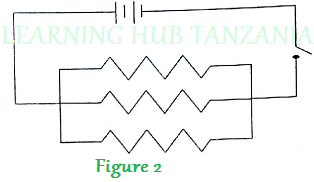
The type of circuit shown in Figure 2 is known as
- series circuit
- parallel circuit
- resistance circuit
- step down circuit
- alternating circuit.
43.A farmer discovered that his hoe made of iron got rust. This is due to the hoe being in contact with
- water and oxygen gas
- water and carbon dioxide gas
- oil and oxygen gas
- soil and oxygen gas
- soil and carbon dioxide gas.
44. A person with HIV can be identified by
- appearance
- attendance in the hospital
- his behavior
- coughing habit
- blood screening.
45. HIV/AIDS patient needs special diet in order to
- recover quickly
- avoid the spread of HIV to people
- have energy for working
- make the body fight diseases
- destroy HIV totally.
46. Marasmus is a disease which is caused by lack of
- balanced diet
- protein
- vitamin
- minerals
- fats.
47. One of the symptoms of AIDS is
- rapid decrease of body weight
- irritation of the pubic parts
- enlargement of legs and stomach
- to lose ability to see
- being angry.
48. Which stage in the scientific investigation is used to accept or reject the hypothesis?
- Data collection
- Conducting experiment
- Writing conclusion
- Data interpretation
- Literature review.
49. The function of red blood cells in human body is
- to cause blood clotting
- to fight against diseases
- to attack bacteria
- to transport nutrients
- to transport oxygen.
50. Observe Figure 3 which shows a simple blood circulation in the human body and answer the question that follows.

Letters which represent blood vessels that transport deoxygenated blood are
- M and P
- N and P
- M and O
- O and P
- M and N.
THE UNITED REPUBLIC OF TANZANIA NATIONAL EXAMINATIONS COUNCIL
PRIMARY SCHOOL LEAVING EXAMINATION
05E SCIENCE
Time: 1:30 Hours Wednesday, 19th September 2012 a.m
Instructions
- This paper consists of fifty (50)questions.
- Answer allthe questions.
- Read all the given instructions in the special answer sheet (OMR)and fill in allthe required information.
- Write your Examination Numberand then shade the digitsof the number in the respective place in your answer sheet.
- Shadethe letter of the correct answer for each question in the answer sheet provided, for example, if the correct answer is A shade as follows:
- If you have to change your answer, you must rub out the shading very neatly• before shading the new one. Use a clean rubber.
- Use HB pencilonly.
- Cellular phones are not allowedin the examination room.
Choose the correct answer and shade its letterbeside each question in the answer sheet provided.
1. In order to sustain a healthy body we are supposed to
- do physical exercise, eat quality food and rest
- sleep for a long time, eat quality food and play
- avoid tough work, do physical exercise and sleep
- do physical exercise and participate in sports and games
- eat well and do physical exercises all the time.
2. Which of the following is an important nutrient for a pregnant woman toget in large quantities?
- Protein
- Carbohydrates
- Fats
- Mineral salts
- Vitamins.
3. Urinating frequently, producing large quantities of urine and frequent thirst are symptoms of which disease?
- Cancer
- Diabetes mellitus
- Kwashiorkor
- Whooping cough
- Anaemia.
4. Which of the following is most appropriate in helping a person who has touched a bare live electric wire and is experiencing an electric shock?
- Quickly push him/her away with bare hands
- Pull out the electric wire causing shock
- Put off the electricity by using water
- Pull him/her away by using insulated materials
- Leave him/her till the power is cut off automatically.
5. _________ is a disease which if left untreated for a long time causes heart and brain problems or even death.
- Chlamydia
- Gonorrhoea
- Trichomona
- AIDS
- Syphilis.
6. Which of the following is nota symptom of AIDS?
- Swollen lymph nodes
- Loss of weight
- Persistent diarrhoea
- Unusual prolonged coughing
- Unusual sweating during night.
7. The following are the ways of preventing hazards in the environment except
- digging trenches
- building houses far from volcanic mountains
- having food storage
- living nomadic life
- maintaining cleanliness in our environment.
8. Which of the following is a mixture of different gases?
- Light
- Air
- Kerosene
- Carbon dioxide
- Vapour
9. Which of the following isnota cause of environmental degradation?
- Burning of papers
- Industrial development
- Bathing in the lake
- Use of farmyard manure
- Car washing along rivers.
10. The King of the forest commanded that all animals which eat meat must be killed. What do you think will happen to the forest after many years?
- Plants will grow in larger quantity
- The number of insects will not change
- Plants will decrease
- Animals eating plants will decrease
- The environment will remain in a good and attractive condition.
11. Natural forces cause one of the following changes in the environment:
- Disappearance of fishes
- Earthquake
- Increase of plants
- Shortage of electricity
- Drying of rivers.
12. Which of the following is not the right way of maintaining soil fertility in a farm?
- Crop rotation
- Growing leguminous plants
- Leaving the land uncultivated
- Applying fertilizers
- Growing the same crop consecutively.
13. How many major stages of growth does a frog undergo?
- One
- Seven
- Six
- Five
- Eight.
14. Which of the following insects undergoes incomplete metamorphosis?
- Mosquito
- Butterfly
- Housefly
- Bee
- Cockroach.
15. A rat which was kept in a cage containing a piece of meat died after two days.Why did the rat die?
- Ate the rotten meat
- Lacked carbon dioxide
- Lacked oxygen
- Lacked enough water after eating the meat
- Lacked light which is essential for the growth of animals.
16. Which of the following organisms is an amphibian?
- Frog
- Rat
- Lizard
- Tortoise
- Chameleon.
17. Animals like crocodiles, hippopotamus and frogs live in what kind of habitat?
- In the sky and on the land
- On the land and in water
- Any kind of environment provided there is food
- On the land and in caves
- In the forests.
18. During pollination, pollen grains move from
- ovary to the ovules
- stigma to the anthers
- petal to the stigma
- anthers to the stigma
- sepals to the style.
19. There are two types of plant seeds known as
- main cotyledon and minor cotyledon
- monocotyledon and dicotyledon
- dicotyledon and main stalk
- seeds with roots and seeds without roots
- natural seeds and wild seeds.
20. Thunderstorm light rays can be seen before hearing the sound of the thunderstorm because
- light rays cannot be prevented by anything
- sound is absorbed by the clouds
- light rays travel faster than sound waves
- sound waves travel faster than light rays
- clouds which produce sound travel slowly.
21. When two pieces of cloth of the same material are washed, one black and the other white in colour, the black one will dry faster than the white one because it
- absorbs heat fast
- reflects light fast
- absorbs moisture fast
- can withstand blowing wind
- has the ability to filter water.
22. Which of the following sets represents liquids?
- Air, water and copper
- Petrol, ice and nitrogen
- Gold, hydrogen and mercury
- Petrol, mercury and water
- Water, petrol and air.
23. Observe Figure 1 below then answer the question that follows.

This symbol in electricity represents
- resistance
- dry cell
- voltmeter
- switch
- bulb.
24. An accumulator is a combination of cells connected together to produce directcurrent which is used in
- bicycles, pressing iron and telephone
- cars, tractors and telephones
- refregirator, pressing iron and fan
- bicycle, refregirator and electrical cooker
- dry cell, charcoal cooker and pressing iron.
25. Study Figure 2 which shows two people, P and Q lifting loads of equal weight to the roof then answer the question that follows.
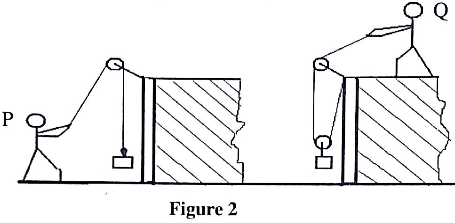
Who will lift the load more easily?
- P because he is on the ground
- Q because he will apply less force
- Q because he is on the roof
- P because there is one roller
- Q because the gravitation pull is less.
26. The ability to move something from one point to another is known as
- balance
- force
- friction
- work
- gram.
27. When a pencil is placed in a glass containing water, the pencil appears bent due to the
- refraction of light
- reflection of light
- dispersion of light
- ability of water to pass light
- density of water.
28. Milk can be processed to make which of the following products?
- Cheese and soap
- Fruits and baking powder
- Cheese and fruits
- Cake and butter
- Cheese and butter.
29. The natural sources of energy in the daily life are
- fire wood, fire and water
- electricity, magnet and natural gas
- fire wood, sun and wind
- fire, wind and magnet
- electricity, wind and water.
30. Observe Figure 3 and select the correct answer about the experiment.
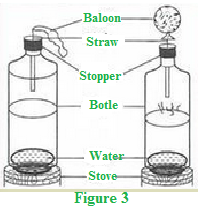
The purpose of the experiment shown in Figure 3 is to demonstrate:
- Boiling drinking water
- Cooling of water
- Expansion and contraction of gas
- Cooling of gas
- Producing oxygen gas.
31. Which of the following is a physical change?
- Fermentation of milk
- Burning of papers
- Water to steam
- Reaction between acid and base
- Decaying of plants.
32. Careful observe figure 4 and answer the following question
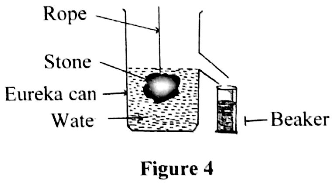
The purpose of the experiment in Figure 4 is to find the
- volume of a eureka can
- amount of air in the eureka can
- area of the stone
- circumference of the stone
- volume of the stone.
33. To prevent hazards causedby science and technological inventions, everynation should
- cooperate with scientists
- have a Ministry of Science and Technology
- do away with science and technological inventions
- acquire technological inventions from developed nations
- formulate policies that guide the use of science and technology
34. Which of the following is used to predict the problem in scientific investigation?
- data collection
- hypothesis
- data analysis
- conclusion
- recommendations.
35. People who go to the moon must
- carry firewood for cooking food
- carry oxygen gas and food
- be careful from dangerous animals
- carry enough carbon dioxide gas and food
- carry carbon dioxide gas and water.
36. The following measurements of heights for six plants were obtained in are search:12 cm, 16 cm, 6 cm, 20 cm, 14 cm and 10 cm. The average height was
- 12 cm
- 14 cm
- 11 cm
- 13 cm
- 17 cm
37. The main artery is divided into smaller vessels known as
- vena cava
- bronchiole
- valves
- capilaries
- veins.
38. Haemoglobin is a compound found in blood within
- white blood cells
- red blood cells
- blood plasma
- yellow bone marrow
- cells that cause blood clotting.
40. Which of the following animals brain is most complex?
- Man
- Horse
- Hare
- Chimpanzee
- Monkey.
41. Rust is a result of the chemical reaction:IRON + Y + WATER.Letter Y stands for
- oxygen
- nitrogen
- moisture
- carbon dioxide
- acid.
42. Which of the following is made of very small particles?
- Gas
- Liquids
- Blood
- Dry cell
- Matter.
43. Which of the following causes anaemia in the human body?
- Lack of vitamin
- Lack of iron
- Lack of calcium
- Lack of protein
- Lack of phosphate.
44. When cooking green vegetables we are advised to
- add some soda ash to ensure that it is well cooked
- cook for a long time to reduce amount of water in it
- cover and cook for a short time
- dry before cooking
- fry using excessive cooking oil.
45. Which of the following is caused by excessive carbohydrates in the body?
- Obesity
- Malnutrition
- Kwashiorkor
- Marasmus
- Goitre.
46. In her experiment, Shida passed light ray through a plane mirror as shown in Figure 5.
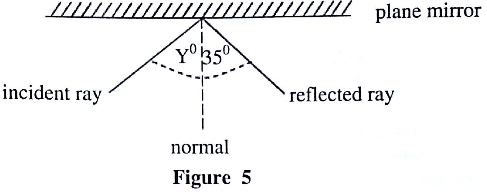
The size of angle Y is
- 180°
- 35°
- 70°
- 90°
- E 105°
47. Which of the following is caused by friction?
- Heat
- Things to fall
- Things to slide
- Velocity
- Force.
48. The shape of the fish helps it to
- breath
- swim
- hunt
- reproduce
- hide.
49. Which of the following organisms live in water?
- Bacteria, virus and fungus
- Sardine, octupus and bacteria
- Bacteria, virus and octupus
- Sardine, octupus and water lilies
- E Bacteria, virus and water lilies.
50. Culex is a type of mosquito which spread worms known as filaria that cause the following disease:
- Tetanus
- Elephantiasis
- Measles
- Hepatitis
- Chickenpox.
THE UNITED REPUBLIC OF TANZANIA NATIONAL EXAMINATIONS COUNCIL
PRIMARY SCHOOL LEAVING EXAMINATION
05E SCIENCE
Time: 1:30 Hours Wednesday, 7th September 2011 aan.Instructions
- This paper consists of fifty (50) questions.
- Answer all questions.
- All answers must be written in the answer sheet provided.
- Cellular phones are not allowed in the examination room.
- Write your Examination Number on your answer sheet.
- Use blue or black pen in writing your answer. Answers written by pencil will not be marked.
Choose the correct .:answer and. write its le `ter beside the questien number in the answer sheet provided.
1. The instrument used to observe cells of living things is called
- Telescope
- Periscope
- Microscope
- Camera
- Horoscope.
2. The sense organ which is used to detect the degree of hotness or coldness is
- tongue
- ear
- eye
- nose
- skin.
3. Which of the following is a mammal?
- Pigeon
- Hen
- Duck
- Bat
- Snake.
4. Figure 1 shows a dicotyledonous seed.
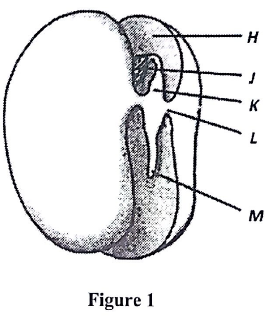
Which of the letters in Figure 1 indicates the part that grows into a root?
- H
- J
- K
- L
- M.
5.What will happen if the flowers of the maize plant are removed?
- The plant will flourish
- The plant will die
- The roots of the plant will not grow
- The leaves will change its color
- The plant will not reproduce.
6.The following are necessary for the formation of carbohydrates in plants.
- Oxygen, chlorophyll and water
- Carbon dioxide, water and sunlight
- Oxygen, carbon dioxide and water
- Chlorophyll, water and sunlight
- Chlorophyll, starch and sunlight.
7 The excretory products from the lungs are
- Oxygen and water
- Oxygen and carbon dioxide
- Carbon dioxide and water
- Carbon dioxide and salt
- Oxygen and salt.
8. Which of the following transfers pollen grains from the stamen to the stigma?
- Man
- Insects
- Water
- Dew
- Style.
9. A person who does not eat fruits and green vegetables is likely to face which of the following problems?
- Suffer frequent illness
- Decrease in body weight
- Increased appetite to eat meat
- Color of the skin become yellow
- Increase in body weight.
10. A child with kwashiorkor is lacking food rich in
- vitamin
- fat
- minerals
- starch
- rotein.
11. Water snails spread disease known as
- bilharzias
- tetanus
- cholera
- measles
- elephantiasis.
12. The main vessel which take blood from the heart is known as
- vein
- aorta
- vena cava
- pulmonary
- hepatic.
13. The hormone which regulates oxygen intake in the human respiratory system is known as
- adrenaline
- insulin
- thyroxin
- estrogen
- amylase.
14. Under normal circumstances, the difference between inhaled air and exhaled air is that exhaled air contain a lot of
- oxygen
- hydrogen
- water
- nitrogen
- carbon dioxide.
15. Disease known as goiter is caused by the deficiency of
- Iron
- Iodine
- Calcium
- Potassium
- Phosphate.
16. Beriberi disease is caused by deficiency in vitamin
- B1
- B2
- D
- C
- A.
17. Fish breath through
- nose
- mouth
- fins
- gills
- scales.
18. Food that has been digested in the small intestine is distributed to other parts of the body through
- water
- oxygen
- blood
- diffusion
- absorption.
19. Which type of fooci among the following is responsibe for repaiiirig human body cells?
- Fat
- Starch
- Fruits
- Protein
- Minerals.
20. Why is family planning important to the family?
- It enables the family to own a house
- It increases the number of children
- It enables the family to travel together
- It makes the family members happy
- It enables the family to get enough food.
21. First aid is the treatment given to
- people who are suffering from known illnesses
- the sick person after being discharged
- show the doctor's expertise in treatment
- the person before being taken to hospital
- show the tasks performed by Red Cross.
22. The purpose of spreading honey on a fresh burn wound is to
- decrease severe pains
- give energy to the body
- provide first aid treatment
- protect the wound from getting dirty
- prevent contraction of tetanus.
23. A person who is vomiting is given which of the following as first aid?
- Boiled milk
- Juice prepared from lemon
- A solution of sugar and lemon
- A solution of sugar and salt
- Rest in a cold and quiet place.
24.Which of the following are necessary for giving first aid to a person with bone fracture without a wound?
- Scissors, bandage, splinter, thread and safety pin
- Towel, soap, stretcher, cotton wool and spirit
- Towel, water, oil, splinter and soap
- Blanket, chair, soap, rope and scissors
- Blanket, bandage, splinter, scissors and rope.
25. After providing first aid to an injured person, the person should be
- given enough drinking water
- sent to a hospital for treatment
- given mouth to mouth ventilation
- laid down under a tree shade
- given complete bed rest
26. The chemical break down of proteins begins in the
- mouth
- stomach
- rectum
- large intestine
- small intestine.
27. The first aid suitable to a person who has taken poison is to
- make him vomit
- give him milk to drink
- provide him with medicine
- give him drinking water
- provide him with glucose.
28. Matter can exist in the following states
- Liquid, water and gas
- Solid, liquid and air
- Solid, liquid and gas
- Stones, solid and gas
- Solid, air and gas.
29. By which of the following methods can salt that has dropped in a bucket of water be separated?
- Filtering the mixture
- Filtering the solution
- Evaporating the solution
- Boiling the mixture
- Evaporating the mixture.
30. In soap manufacturing, sodium hydroxide is mixed with boiling fat. If sodium hydroxide is not available, which one of the following can be used?
- Ash from leaves
- Solution of lemon
- Cassava flour
- Coconut oil
- Pawpaw leaf extract.
31. Melting of ice refers to which type of change?
- a chemical change
- a physical change
- an environmental change
- a biological change
- a physiological change.
32. The natural way of fertilizing the soil is to
- mix cow dung with artificial fertilizers
- burn all trees which dry water sources
- burn leaves and remains of maize plants
- reduce the number of cows grazing on the land
- cultivate leguminous crops by rotation.
33. The simplest method of changing hard water to soft water is to
- use water cleaner
- dilute the water
- boil the water
- melt the solid portion
- filter the solids.
34. Which of the following can be separated by magnet?
- Iron particles and sand
- Flour and pieces of paper
- Plastic pins and sand
- Glass particles and sand
- Sand and rice.
35. Changes of weather and water are agents which help
- the soil surface to look good
- animals to adapt themselves
- plants and animals to exist
- to speed soil erosion
- to balance food chain.
36. The gas which supports combustion is
- hydrogen
- nitrogen
- ozone
- natural gas
- oxygen.
37. Observe Figure 2 carefully and then answer the question that follows. 10 cm 8 cm
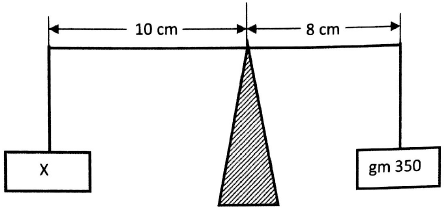
Figure 2
Find the value of X in Figure 2.
- 250 gm
- 280 gm
- 437.5 gm
- 240 gm
- 175 gm.
38. The inside walls of a thermos flask have silver coating in order to avoid loss of heat through
- conduction
- reflection
- convection
- refraction
- radiation.
39. The retina of the eye is similar to which part of the camera?
- Film
- Lens
- Bulb
- Switch
- Focus.
40. Heat is transferred in solid matter through
- conduction
- convection
- radiation
- vibration
- absorption.
41. In machines the mechanical advantage is the ratio between
- force exerted at the fulcrum to the force exerted by the load
- the distance from the fulcrum to the distance where the load is placed
- force exerted by the load to the force exerted at the fulcrum
- the distance from the load to the distance where the fulcrum is placed
- the force applied at one point to the force at the other point in the machine.
42. Identify the mirror which gives an upright image that resembles the real object and is at equal distance from the mirror to the image and to the real object.
- Concave mirror
- Biconcave mirror
- Convex mirror
- Prism mirror
- Plane mirror.
43. The electric current in the circuit is 2 amperes. If the voltage in the circuit is 4 volts the resistance will be
- 3.5 ohm
- 4 ohm
- 2 ohm
- 5 ohm
- 0.5 ohm.
44. Observe the electric circuit shown in Figure 3 and then answer the question that follows.
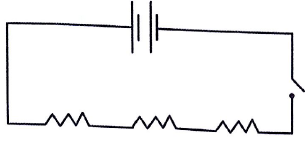
Figure 3
What is the name of the circuit shown in Figure 3?
- Series circuit
- Parallel circuit
- Resistance circuit
- Alternating circuit
- Low tension circuit.
45. Venereal diseases are spread by
- touching one another
- blood transfusion
- playing together
- sharing cups
- sexual intercourse.
46. Which blood cells in human body are attacked by HIV?
- Red cells
- Platelet cells
- White cells
- Sickle cells
- Plasma cells.
47. The proper method of preventing people from getting HIV is to
- stop drinking alcohol
- avoid unprotected sex
- participate in religious preaching
- distribute drugs to the victims
- publicize the names of the victims.
48. Which of the following sentences is true about HIV/AIDS?
- HIV is spread by mature people only
- Healthy looking people do not have HIV
- HIV/AIDS affect people of all ages
- All people suffering from cancer have HIV
- Vaccination prevents contraction of HIV.
49. The service that needs to be given to people living with HIV is to
- give them houses for living
- give them financial assistance
- give them counseling
- give them free education
- to assist them in opening bank accounts.
50. In scientific investigation data collection is done by
- travelling to various places
- reading different literature
- identifying the problem
- formulating hypothesis
- doing several experiments.
THE UNITED REPUBLIC OF TANZANIA NATIONAL EXAMINATIONS COUNCIL
PRIMARY SCHOOL LEAVING EXAMINATION
05E SCIENCE
Time: 1:30 Hours Monday, 6" September 2010 o.m.
- This paper consists of 50 questions in sections A and B.
- Answer all questions.
- MI answers must be written in the answer sheet provided.
- Cellular phones arc not allowed in the examination room.
- Write your Examination Number on your answer sheet.
SECTION A
Choose the correct answer and write its letter beside the question number in the answer sheet provided.
1. Whieh among the following is not an advantage of sports and games for our health?
- Helps to build muscles.
- Prevents the body from being attacked by diseases regularly.
- Causes high blood pressure.
- Entertains the body.
- Maintains body health.
2. Water mixed with sugar and salt is the first aid given to a patient suffering from
- malaria and headache
- diarrhoea and vomiting
- meningitis and typhoid
- tuberculosis and flue
- broken leg or hand.
3. One of the following diseases is not sexually transmitted:
- AIDS
- Trichonoma
- Syphilis
- Clamedia
- Trichoma.
4. Which of the following vitamins is made in the body in the presence of sunlight?
- Vitamin A.
- Vitamin B.
- Vitamin C.
- Vitamin D.
- Vitamin E.
5.What is the importance of vaccination to human beings?
- Reduces pain.
- Cures illness.
- Prevents diseases.
- Replaces vitamins and minerals in the body.
- Replaces worn out cells in the body.
6. What type of bacteria causes tuberculosis?
- All of those present in air.
- Basilli.
- Plasmodium.
- Fungus.
- Amoeba.
7.Factories are not supposed to be built near human settlements because
- their construction occupies big area
- large part of factory effluents contain poisonous chemicals
- factory machines make loud noise which can affect ear drums
- factories make people to shift from their settlement
- factory owners do not keep their environment clean.
8.The following activities destroy water sources except
- cutting of trees
- burning of forests
- overgrazing along water sources
- throwing chemical rubbish into water sources
- fetching cooking water from water sources.
9. A large percentage of the earth's surface is covered by water. Most of this water is found in the
- ocean
- rivers
- lakes
- dams
- ponds.
10. The highland area is the best place for pit latrine construction because
- it is easy for wall construction
- the bad smell will be far away from surface level
- it is not easily damaged
- water will be far away from the latrine itself
- the latrine will not overflow in a short time.
11. An outflow of ground water is known as
- Sea
- Lake
- Spring
- Darn
- River.
12. The necessary requirements for seed germination are
- soil, sunlight and water
- soil, air and water
- optimum temperature, water and oxygen
- optimum temperature, soil and sunlight
- water, soil and carbon dioxide.
13. A group of living things that live in both water and land is known as
- Amphibian
- Arthropoda
- Fish
- Birds
- Mammals.
14. Which among the following organisms is not a mammal?
- Bat.
- Whale.
- Lion
- Rabbit.
- Crocodile.
15. Carefully study Figure 1 then answer the question that follows.

Figure 1
The organism which is shown in Figure 1 feeds on
- honey
- flesh
- Grains
- aquatic food
- decayed matter.
16. What kind of habitat suits a plant with characteristic features of the plant drawn in
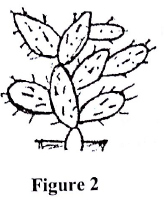
- Heavy forest.
- In Water
- Grassland
- Desert.
- Mountains.
17.Why do some plants not shed their leaves during rain seasons?
- To conserve water
- To allow transpiration
- To conserve food
- To conserve soil
- To make the soil fertile.
18.The diagram in Figure 3 shows a picture of a flower.
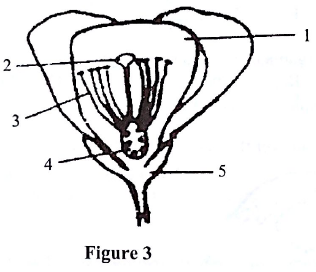
Which part attracts insects for pollination?
- 1.
- 2.
- 3.
- 4.
- 5.
19. Electricity produced by a dry cell originates from which type of energy?
- Solar.
- Mechanical.
- Sound.
- Magnetic.
- Chemical.
20. Kibata used 50 newtons to push a wall from morning to evening unsuccessfully, Which of the following is correct with regards to the action?
- He was dodging the work.
- He used a lot of force
- He didn't do any work
- He did a good work
- He used little force.
21. If the angle of incident ray on the plane mirror is 60°, what is the value of the angle of reflection?
- 90°.
- 40°.
- 30°.
- 60°.
- 450.
22. Observe Figure 4 then answer the question that follows.
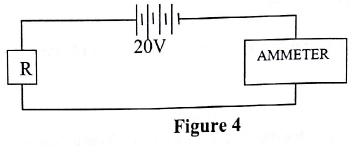
If electric current passing through the circuit is 5 amperes, the resistance of the wire in the circuit is ohm.
- 100
- 50
- 10
- 4
- 0.4.
23.Mzee Juakali hang a bar magnet in the air. Which direction will the north pole of the magnet point to?
- South.
- North.
- East.
- West.
- North — East.
24.Musa spent 10 newtons to push a wheelbarrow a distance of 5 metres. The workdone by Musa was equivalent to how many Joules?
- 15.
- 50.
- 3.
- 0.5.
- 5.
25.In a scientific investigation, what makes a person foresee the results?
- Realising a problem.
- Long investigation.
- Seeing by naked eyes.
- Doing experiment.
- Touching something.
26.The experiment on seed germination was conducted as in Figure 5.
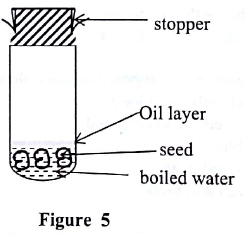
What is the important thing missing for seed germination?
- Water.
- Air.
- Soil
- Fertilizer.
- Wind.
27. In scientific experiments, sense organs used to identify things are
- nose, eyes, skin, tongue and cars
- nose, ears, skin, legs and tongue
- ears, skin, nose, legs and arms
- ears, nose, skin, eyes and arms
- eyes, legs, tongue, cars and nose.
28. The following data were obtained after measuring the heights of five plants in cm: 10, 12, 15, 28 and 40. The average height of the plants in cm is
- 22
- 50
- 27
- 38
- 21.
29. What is the major purpose of producing different types of hybrid seeds?
- To reduce height of plants.
- To increase plants products.
- To fasten plants growth.
- To obtain plants which tolerate draught.
- To increase the height of plants.
30. Which one of the following instruments is used to measure length?
- Kilogram.
- Centimetre.
- Ruler.
- Volt.
- Ampere.
31. The ozone layer is important in
- increasing heat on the earth surface
- decreasing sun rays reaching the earth
- reducing the amount of carbon dioxide in the sky
- increasing the amount of rainfall on the earth
- decreasing coldness.
32. The most shining planet is
- Mercury
- Earth
- Jupiter
- Pluto
- Venus.
33. How many days does the earth take to make one revolution around the sun?
- 365 1/4.
- 28.
- 24.
- 12.
- 7.
34. The blood circulatory system is composed of the following:
- Heart, white blood cells and blood
- White blood cells, red blood cells and blood vessels
- Heart, lungs and blood
- Blood cells, water and heart
- Heart, blood vessels and blood.
35. Waste products filtered by the kidney are carried to the gall bladder through a tube called
- bronchiole
- urethra
- eusophagus
- ureter
- fallopian.
36. Study figure 6 of the tooth then answer the question that follows
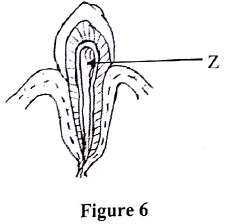
Letter Z in the figure represents____
- enamel
- crown
- dentine
- blood vessels
- gum.
37.Which part of the heart pumps blood to various parts of the body?
- Left auricle.
- Left ventricle.
- Right auricle.
- Vena cava.
- Right ventricle.
38.Study Figure 7 and then answer the question that follows:
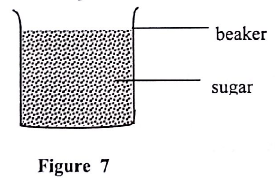
In which state of matter is the sugar inside the beaker?
- Liquid.
- Gas.
- Solid
- Element.
- Compound.
39. Rusting of iron is an example of which change of state?
- Chemical.
- Physical.
- Colour.
- Liquid.
- Mass.
40 Which among the following groups of food represents food rich in vitamin A?
- Orange, lime and lemon.
- Carrot, milk and liver.
- Orange, yeast, beans.
- Lime, orange, liver.
- Fish, milk, lime.
41. Which measure should be taken to prevent malnutrition
- Eating a lot of food.
- Educating parents about quality food.
- Keeping our environment clean.
- Keeping our bodies clean and neat.
- Eating fried food with a good smell.
42.If there is no change in the weight of matter, what name is given to such a change?
- Chemical.
- Hardness.
- Physical.
- Length.
- Width.
43.Marasmus is a type of malnutrition caused by
- deficiency in calcium and phosphorus
- overfeeding
- deficiency in iodine
- deficiency in protein
- inadequate food which provides energy and heat to the body.
44. What type of nutrients are found in body building foods?
- Protein.
- Cabohydrate.
- Vitamins
- Minerals.
- Fat.
45. Study the following food chain then answer the following question.
PLANT → BUFFALO → CHEETAH.
In this food chain, what will happen if cheetah will migrate from the environment?
- Plants will dry out.
- The number of buffalos will decrease.
- Plants will increase.
- Plants will decrease.
- Buffalo will migrate away too.
SCIENCE 2009
SECTION A
Choose the correct answer and write the letter in the correct column next to each question on the answer sheet.
1. You can help someone who has fainted by:
- give him fresh air
- shaking him violently
- lying on his face
- squeezing the abdomen slowly
- put a towel of cold water on her face
2.......... is caused by a deficiency of vitamin A.
- Malnutrition
- Dry eyes
- Rickets
- Intestinal
- Infertility
3. The importance of the pediatric clinic card is to facilitate the characters
- to know the date on which the child was born
- ensure that the child was born
- appreciate the developmental development of the child
- easy access to health care
- go with the times
4. What first aid should a diarrhea patient receive?
- take her to the doctor early
- give him pills to relieve pain
- give him water mixed with lemon, sugar and salt
- refer her to a traditional healer
- give him enough food
5. The main means of transmitting HIV to humans are:
- piercing ears and nose
- blood transfusions
- sexual intercourse
- accident
- injecting needles
6. Panda was forbidden by her mother to play with snails. What disease do you think his mother was keeping him from?
- Bilharzia
- diarrhea
- malaria
- sleeping sickness
- AIDS
7. Todi opened the gas from the pitcher and directed it to the fire. The fire lit up more. What gas did the jug contain?
- oxygen
- carbon dioxide
- monoxide
- Hydroxide
- wind gas
8. Some of the natural disasters that can endanger plants and forests are:
- rain accompanied by hurricanes, droughts and volcanoes
- fire, drought and volcano
- rain accompanied by hurricanes, fires and volcanoes
- fire, drought and rain accompanied by storms
- fires, chemicals in plants and livestock in excess
9. During the day, what do green plants reduce in the atmosphere?
- carbon dioxide
- nitrogen
- hydrogen
- oxygen
- nitrate
10. It is recommended where to build a pit latrine:
- in the valley near the river
- inside the living house
- a short distance from the living house
- very flat
- very close to the living house
11. If the issue in the next debate increases, what will happen soon? LEAVES → ANTELOPES→ LIONS
- the leaves will reduce
- lions will die
- the number of lions will not change
- the amount of leaves will not change
- the leaves will increase
12. After fertilization, the baby frog is called:
- larvae
- maggot
- locust larvae
- tadpole
- egg
13. The two parts of the fence that connect to the stamens are:
- seeds and pistils
- style and stalk
- ovary and sepal
- petals and sepal
- filament and anther
14. The second step in the metamorphosis of cockroach is:
- lava
- locust larvae
- maggot
- complete cockroach
- egg
15. Where do plants usually grow?
- on water
- in the light
- wind direction
- on fertility
- dark
16. The part of the flower that receives pollen is called:
- style
- stigma
- ovaries
- stamens
- ovule
17. The following diagram shows an aquatic creature.
|
|
| Figure 1 |
What part of his body helps him to swim?
- U
- R
- T
- V
- S
18. What organ is responsible for turning red blood cells into bile in the human body?
- liver
- kidney
- heart
- lungs
- spleen
19. The following are sources of electricity generation except:
- waterfall
- solar energy
- thunderstorms
- fuel
- wind
20. Describe the energy changes that occur in the following Figure when steam is used to rotate the fan:
|
|
| Figure 2 |
- electricity becomes a sound
- The sound became heat
- heat to be mechanical energy
- sounds become electricity
- lightning becomes a magnet
21. In what of the following areas does heat travel by conduction?
- water and iron
- iron and aluminum
- aluminum and vapour
- air and water
- air and iron
22. In Figure 3, which diagram shows a parallel circuit?
|
|
| Figure 3 |
23. Which of the following machines is the simplest machine?
- bicycle
- motorcycles
- winch
- lever
- car
24. The major components of biogas energy are:
- carbon dioxide
- oxygen
- nitrogen
- natural gas
- vapour
25. Scientific research begins with:
- questions
- examination
- presumption
- curiosity
- data
26. In a scientific experiment the data means:
- a statement of what happens when you make an attempt
- a list of materials you will use in the experiment
- report of a valid experiment
- step-by-step layout how to do the experiment
- proposals for problem-solving measures
27. 212 Fahrenheit fibers are equivalent to Centigrade fibers
- 100
- 108
- 176
- 40
- 75
28. In scientific experiments at what point do scientists use data to accept or reject speculation?
- the first step
- the second step
- the third step
- the fourth step
- step five
29. The experimental report should be based on a series of the following:
- goal, cost, comments and suggestions
- goal, materials, methods, results and conclusions
- goal, procedures, results and conclusions
- goal, materials, comments and suggestions
- the goal, the experiment itself and the recommendations
30. Mpemba plunged the stone into a measuring cylinder filled with water. The displaced water was 200 cubic centimeters. Which sentence is correct about the act?
- water is heavier than stone
- stone is heavier than water
- the remaining water is less than that which came out
- the volume of the stone is the same as that of the displaced water
- the weight of the discharged water is equal to the remaining water
31. Examine the following diagram of evaporation and flooding, then answer the following question:
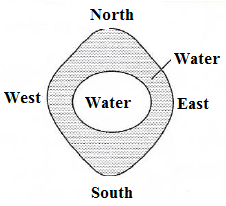
If the water rises on the North they will fall on........sides of the earth?
- south and east
- south and west
- east and West
- north and west
- north and east
32. "Morning Star" is a popular name for the planet called
- Satan
- Pluto
- Mercury
- Venus
- Jupiter
33. The following are natural objects found in the sky with the exception of one that is:
- moon
- the sun
- satellite
- meteors
- planet
34. Fish live only in water and cannot survive on land. This is because on dry land it cannot:
- move
- jump
- hearing
- breathing
- to see
35. Which of the following statements is correct about motor nerves?
- carries information from body parts to the central nervous system
- carries information from the central nervous system to parts of the body
- transmits information from the central nervous system to the spinal cord
- connects consciousness only in parts of the head
- transmits and returns information to the spinal cord
36. Examine the following diagram and then answer the next question.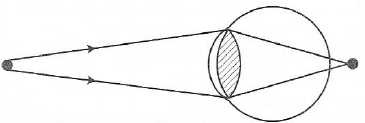
What is the defect in the figure?
- Long sightedness
- blurred vision
- short sightedness
- squint
- small lens
37. During pregnancy the baby usually receives food and air from the mother through:
- uterus
- placenta
- fallopian tubes
- ovaries
- the mouth
38. Factors that cause rust on nails include air oxygen, which is one of the following?
- carbon dioxide
- water
- cotton
- aluminum
- zinc oxide
39. When an object is in extreme heat, it cools down. In what order does change occur?
- gas → liquid → solids
- solids → liquids → gases
- gas → solids → liquids
- liquid → gas → solids
- liquid → solids → gases
40. Deficiency of iron supplements in the body causes:
- weight loss
- having a face similar to that of an old man
- weakness in the bones
- blood redness
- loss of appetite
41. The organisms that can cause food to rot are:
- virus
- plasmodium
- bacteria
- cockroach
- bed bug
42. A yellow fever patient is advised to eat foods that contain:
- vegetables
- protein
- sugar in abundance
- a small amount of sugar
- protein and water in abundance
43. Which of the following vitamins works to clot blood on a wound?
- K
- E
- D
- C
- B
44. The part of the blood that requires a lot of iron during manufacture is:
- Blood platelets
- plasma
- white blood cells
- red blood cells
- lymph nodes
45. Why do the leaves of some plants curl in hot weather?
- they do pollination
- they make food
- do not lose direction
- do not waste too much water
- do not damage and lose color
SCIENCE 2008
SECTION A
Choose the correct answer and then write the letter in front of each question in your answer sheet.
1. In addition to helping build muscle, what do sports strengthen?
- legs
- Body parts
- Head links
- Hands
- Joints of the upper part of the body
2. The main benefits of family planning are.........
- educating children
- making the number of children larger
- to be able to build a stable home for the family
- avoid problems
- be able to provide all the necessary services to the family
3. Which of the following groups provides first aid training as well as the service itself?
- Red cross
- He shines
- Firefighters
- Good Samaritans
- Road safety officers
4. Food that provides the body with all the nutrients in the right proportions is:
- a protein-rich diet
- a diet rich in protein and carbohydrates
- a balanced meal
- well-cooked food
- fragrant food
5. Namanji seems to bend her legs. What minerals do you think he lacks?
- Calcium
- Sodium
- Magnesium
- Iron
- Aluminum
6. The following are vaccine-preventable diseases in children:
- Whooping cough, polio, tetanus and measles
- Diarrhea, chickenpox, measles and typhoid fever
- Polio, kwashiorkor, tetanus and diphtheria
- Chickenpox, Marasmus, measles and polio
- AIDS, tuberculosis, tetanus and diarrhea
7. Convulsions are caused by:
- bird flu disease
- severe cough
- high fever
- cholera
- HIV/AIDs
8. Mama Katu entered the room and found her husband lying on the floor after being electrocuted. Mama Katu will help her husband by:
- give him clean drinking water
- give him milk
- shaking him violently
- blowing air
- to bathe him
9. Air is a combination of:
- Oxygen
- carbon dioxide
- gases
- vapour
- water and oxygen
10. Water in vapour conditions are:
- Clouds
- rain
- ice
- dew
- humidity
11. One of the following measures prevents soil erosion:
- Reduce the number of trees
- Burning forests
- Planting trees
- Grinding the grass
- Increase the number of livestock
12 The caterpillar is the lava of
- grasshopper
- cockroach
- frog
- butterfly
- mosquitoes
13. What can lead to a "positive change" in natural resources?
- Fishing using poison
- Arbitrary cultivation in the highlands
- Deforestation near water sources
- Fishing using dynamite
- Growing trees and grasses
14. The following are the key characteristics that characterize living things. What qualities do you think are not involved?
- respiration
- Growth
- Make their own food
- movement
- reproduction
15. The part of the seed that stores food for the germination of seed is:
- cotyledon
- testa
- embryo
- foetus
- stalk
16. Examine the leaf of the plant shown in the figure and then answer the question that follows.
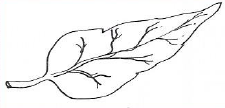
Which of the following leaves can you compare it to?
- Rice
- Millet
- Cow peas
- Maize
- Coconut
17. Wax is made from ......... of bees.
- glands
- Wings
- Eyes
- Feet
- abdomen
18. What is the part of the flower that attracts insects that come to the plant and help pollination and pollination?
- Petal
- Sepal
- Stigma
- stalk
- Pistil
19. The frog's back is short enough to enable him .........
- run
- to sleep
- fly
- jump and land
- turn
20. Which of the following items transports heat faster?
|
|
- A
- B
- C
- D
- E
21. One seventh grader put a pencil in a glass of water. Choose a diagram showing what the pencil will look like from the following:
|
|
22. If you look at a person who is cutting down a tree from a distance you will see the act of cutting the tree before the sound of the tree is heard because:
- the ax is blunt
- sound travels slower than light
- light travels slower than sound
- the task of cutting a tree is difficult
- the cutter does not use force
23. Observe the following diagram. What is the amount of electric current?
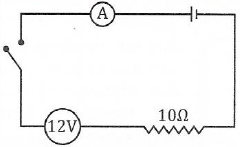
- 0.2
- 2.0
- 12
- 20
- 1.2
24. In which of the following devices do you use direct current?
- Refrigerator
- Electronic iron
- Fan
- Electric cooker
- Flashlight
25. The whole area affected by the magnetic field is known as:
- the ends of the magnets
- north pole
- the southern pole
- iron fillings
- magnetic field
26. Brother Chapakazi used 10 N to lift a load for height of 5 meters. How much did Brother Chapakazi work?
- 100 joules
- 20 newtons
- 20 joule
- 50 joule
- 10 kg
27. One of the following is a complex machine:
- Scissors
- ladder
- Knife
- Flashlight
- Bicycles
28. A scientist passed gas into a liquid where it turned milky. What is that liquid and what is that gas?
- Lime water - oxygen
- Orange water - carbon dioxide
- Lime water - nitrogen
- Lime water - carbon dioxide
- Milk - oxygen
29. The state of observing things or events by asking yourself is:
- astronomy
- curiosity
- scholarship
- empathy
- accountability
31. Diana took a potato and carved it to make a hole in the middle, and in it she put the salt solution, and then put it in a bowl with a little water. After four hours the water rose in the salt potato. What did Diana discover?
|
|
- Water flows from weak solution to the concentrated solution
- Plants get water that way
- Salt is lighter than water
- Potatoes are not compatible with salt
- Conclusion
31. In writing the report of a scientific experiment the fourth thing to write is:
- procedure
- equipment
- results
- purpose
- conclusion
32. The following diagram shows the height of the students in centimeters when they were measured late last year at Pangani Primary School. How many students does the school have in total?
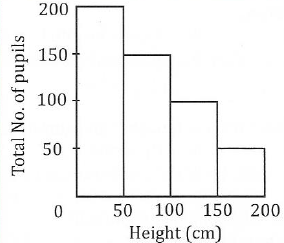
- 200
- 500
- 100
- 1000
- 50
33. Fruits fall from the tops of trees. This indicates the presence of force:
- lift
- dragging
- gravitational
- pushing
- perpendicular
34. Urine is filtered in:
- liver
- lungs
- kidney
- bladder
- spleen
35. The basic dimensions of electricity are:
- wire, battery, ohm
- joule, battery, bulbs
- joule, ampere, battery
- ohm, volt, ampere
- meter, kilograms, seconds
36. Digested food is broken down by............... those in the small intestine.
- Hemorrhoids
- pancreas
- villi
- esophagus
- virus
37. Mama Mambosasa has identical twins. What happened inside the mother's womb?
- Two eggs were fertilized by different gametes
- The two eggs were split in two
- The fertilized egg divided into two parts
- Two eggs were fertilized by one male gametes
- Three eggs were fertilized by a different male gametes
38. Examine the following illustration and then answer the question that follows.

The part shown with the letter M is called:
- dendrite
- axon
- cytoplasm
- nucleus
- nerve platelet
39. When the oxyhaemoglobin reaches the cells that need oxygen it is secreted to produce the oxygen that is used for:
- eliminating disease
- generating body temperature
- transpiration
- respiration
- regulating blood
40. The following living organisms are said to contribute significantly to environmental degradation.
- Trees
- Cattle
- Human
- Crow
- Elephant
41. Which of the following is a chemical change?
- Freezing water into ice
- Melting of fats
- Cloudy and rainy formation
- The candle melts
- Iron to get rusty
42. In human growth how old is the age when counseling is most needed?
- 0 -5
- 6- 10
- 11 - 18
- 19-25
- 26-30
43. To prevent bleeding gums what foods are we advised to eat?
- Lemons, oranges, papayas and leafy vegetables
- Rice, beans, meat and fish
- Potatoes, bananas, cassava and millet
- Meat, fish, milk and eggs
- Peanuts, beans, cashews nuts and coconut
44. Songanane School was found to have high school students. What is the problem with the lack of nutrients?
- Protein
- fats
- starch
- Vitamins
- Mineral Salt
45. The following are the types of malnutrition except:
- Dry eyes
- kwashiorkor
- infertility
- intestinal tract
- measles
SCIENCE 2007
SECTION A
Choose the correct answer and then write the relevant letter in front of the number of each question on the answer sheet.
1. The importance of carbohydrate foods in the body is
- Body building
- Protect the body
- Strengthening
- Ability to think
- Increase heat
2. If you were in a dark room and suddenly the light came on what would happen to the eye?
- The pupil will increase in size
- The pupil of the eye will remain the same
- The lens of the eye will change
- The pupil will decrease in size
- Loud noise will be heard
3. Dry cough, fever, night sweats and coughing up blood are symptoms of. . . . . .
- Tuberculosis
- Smallpox
- Tetanus
- Typhoid
- Epilepsy
4. The diagrams in Figure 1 represent cells in the human body whose functions are:
|
|
| Figure No. 1 |
- Prevent and protect the body against diseases
- Transporting oxygen
- To clot blood
- Adjust body temperature
- Transporting waste in the body
5. What disease is a person with obesity likely to get?
- Heart and high blood pressure
- Cancer
- Marasmus
- mental retardation
- Kwashiorkor
6. Manure and other decayed plant and animal things
- It makes the soil unsuitable for agriculture
- They invite other pests to destroy crops
- They add compost to the soil
- They have no significance in soil
- They are used as fish prey for fishermen.
7. Light and sound have only one characteristic. What is that characteristic?
- Refraction
- Reflection
- Absorption
- Passing through a vacuum
- Dispersion
8. Storing foods in the refrigerator is a way that.
- It makes foods last longer without spoiling
- It reduces the work of cooking severally
- It loses its flavor and makes them rot if it stays for long
- turning food into ice
- Reduces the cost of going to the market.
9. If you put a 20 shilling coin in a basin with water, the coin looks like it has bend on top. This situation happens because.........
- The coin is light
- Eyes have problems
- The light is straight
- Water is little
- A ray of light bends as it enters in the water
10. Why are soda and beer bottles not filled to the brim?
- For gas space
- Helps close bottles easily
- Allow to expand during hot weather
- Reduce costs
- When filled it can spill into the drinker
11. Active volcanoes produce heavy liquid on the earth's surface called:
- Lava
- Crater
- Gas
- Volcano
- Water
12. Why do light usually appear first before lightning, even though both occur at the same time?
- Light has bigger waves than sound
- The optic nerve works faster than the sensory nerves
- The speed of light is faster than that of sound
- Light and sound usually travel vertically
- Sound waves do not travel in the air
13. Which among the following things can cause air pollution?
- Industrial wastewater, alcohol and commercial construction
- Smoke, Ash and Fertilizers
- Industrial smoke and the results of burning petrol
- Natural forests, industries and fertilizers
- Fertilizers, compost and industrial wastewater
14. Which of the following creatures lives in the water?
- Flies
- Spiders
- crab
- Grasshopper
- cockroach
15. The growth of mosquitoes goes through four main stages. The proper flow of such growth is. . . . . . . . .
- Egg, pupa, larva, mosquito
- Pupa, egg, larva, mosquito
- Egg, larva, pupa, mosquito
- Larva, egg, pupa, mosquito
- Pupa, larva, egg mosquito
16. The act of a plant following light in Figure 2 is called.........
|
|
| Figure No. 2 |
- Walking
- Growing
- Moving
- Respond to the stimuli
- Feeling
17. The source of food for animals is.........
- Plant
- Plants and meat
- Plants for herbivores and meat for carnivores
- Milk
- Beans
18. Cooking utensils have handles made of wood and plastic because....
- It does not pass heat quickly
- It does not pass heat
- They absorb heat
- It reflect heat
- Keeps heat for a long time
19. The walls, coins, and ceiling of the broadcasting hall have been fitted with soft things in order to.
- Reduce sound
- Reflect
- Increase sound and power
- make the sound soft and clean
- Reduce echo
20. What is the relationship between magnetism and electricity?
- They are all chemical energy
- They are all electrical circuits
- Wherever there is magnetism there must be electricity
- Wherever there is electricity there must be a magnetism
- Both provide light energy
21. In the diagram of the electrical circuit it represents:
![]()
- Dry cells
- Cell
- Fuse
- Transformers
- Adaptor
22. Which group represents the simplest machine?
- Hammer, axe, knife, scissors
- Scissors, car, wheelbarrow and nail
- Axe, screws, scissors and a sewing machine
- Lock, wheelbarrow, bicycle and saw
- Bicycle, car, sewing machine and hammer
23. When a person pushes a wheelbarrow, his/her hands and the handles of the wheel make.
- A fulcrum
- Load
- Effort
- A lever
- Energy
24. The compass points to the north of the earth because.........
- There is a magnetic field interlocking within the world
- People are more used to the northern point
- It is not easy to get lost if you are in the north
- Early inventors discovered more
- The north point is higher than the south
25. What changes will occur if a person breathes on the glass surface?
- Freezing
- Melting
- Evaporation
- Condensation
- Expansion
26. The pods in leguminous plants contain bacteria that absorb and change.........to be nitrogen.
- Nitrogen
- Urea
- Phosphorus
- Hydrogen
- Ammonium sulphate
27. Carefully examine Figure 3 and then answer the question that follows
|
|
| Figure No. 3 |
What is the volume of stone after immersion in water?
- 15 cm 3
- 45 cm 3
- 30 cm 3
- 5 cm 3
- 20 cm 3
28. The melting of the ash from the banana leaves can change the litmus sheet .........
- Blue to red
- Red to blue
- Blue to yellow
- Red
- Blue
29. The scientific experimental report is written in the following order
- Methods, material, purpose, results, conclusions
- Methods, materials, purpose, conclusions, results
- Methods, materials, results, purpose, conclusions
- Purpose, methods, materials, results, conclusions
- Purpose, materials, methods, results, conclusions
30. The gland in the brain that works to stimulate other glands to function is called
- Pancreas
- Gonad
- The adrenal gland
- Thyroid gland
- Pituitary gland
31. Which of the following blood vessels takes blood to the lungs?
- Venacava
- Pulmonary artery
- Aorta
- Pulmonary vein
- Renal vein
32. In which part of the body are red blood cells formed?
- Red bone marrow
- Heart
- Stomach
- Liver
- Lungs
33. What is the best natural method of contraception?
- Using a condom during sexual intercourse
- Using the loop method
- Using injections
- Using summer birth control pills
- Abstinence in the period of danger
34. The part of the seed that stores plant nutrients in the soil is ..
- Embryo
- Test
- Cotyledon
- Epycap
- Nesta
35. Female eggs are formed on
- Testicles
- The fallopian tubes
- Uterus
- Ovaries
- Cervix
36. The end product of a protein digestion is.........
- Fatty acids and glycerin
- Amino acids
- Glucose
- Hydrochloric acid
- Soft sugar
37. The part of the flower that is similar to the female reproductive organ in the human body is.........
- Stigma
- Stamen
- Ovule
- Ovary
- Style
38. We are advised to plant trees in large quantities in arid areas
- Prevent erosion
- Bring shade
- Finding firewood
- Find wood and fruit
- helping to bring rain
39. People living in cold climates should eat more fatty foods because these foods. ... . . . . .
- Defends the body
- It builds the body
- It brings heat
- soothes hunger
- It brings strength
40. When we take pictures using a camera we use one of the light features that feature is.
- Reflection of light
- Light travel in a straight line
- Bending of light
- Light dispersion
- Absorption of light
41. Lightning rods are made of copper because of copper
- It does not rust
- It does not pass electricity
- It is not affected by water
- It fights easily with chemicals
- It passes electricity easily
42. Which of the following diseases can you get from eating raw meat?
- Blister
- Kwashiorkor
- Tapeworm
- Malaria
- Infertility
43. Which of the following causes lung cancer?
- Smoking tobacco
- Drink beer
- Vaccination against cholera
- Drinking Tea
- Drink soda
44. If a person is very dependent on alcohol and cannot stop it, he has a problem with a condition known as.........
- Malnutrition
- Excessive alcoholism
- Fainting
- A disease that kills liver cells
- Depression
45. Which of the following is the main source of vitamin C?
- Cheese
- Oranges
- Beans
- Meat
- Eggs
SCIENCE 2006
SECTION A
Choose the correct answer and then write the appropriate letter in the front of each question in your answer sheet.
1. Which of the following represents a physical change?
- Water to be steam
- Burning paper
- Honey turns into alcohol
- Iron to get rusty
- Wood to be charcoal
2. One of the listed below helps to preserve the environment and is:
- cutting down trees for firewood and building;
- crop rotation;
- using chemical fertilizer;
- clearing fields by tilling;
- Grazing cattle in large numbers.
3. What is the hardest mineral?
- Diamonds
- Coal
- Copper
- Mica
- Gold
4. Meat, fish, milk and eggs are foods of:
- Energy giving
- to defend the body
- body building
- warming the body
- perishable and hard to preserve
5. Plants absorb water and mineral salts in the form represented by the letter L in the following diagram. What is that method?
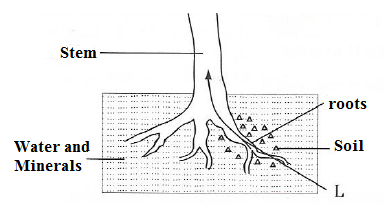
- water and mineral flow
- translocation
- phototropism
- Osmosis
- photosynthesis
6. Wheel axle is a machine.........
- complex used to lift things up
- solid held by a small wheel
- with interlocking teeth of another wheel
- easy to use to lift things up
- Which is used to lift heavy objects?
7. Which number in the diagram below represents a hormone-releasing gland that prevents a person from getting diabetes?
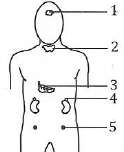
- 1
- 2
- 3
- 4
- 5
8. The ship floats in the water (sea or lake) because it contains:
- a large hollow space inside
- a little airy space
- lighter than water
- waterproof plaster line
- it is less dense than water
9. This experiment (carefully examine the following diagram) reveals that light
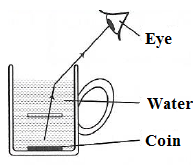
- travels and divides objects into two parts
- travels in a straight line
- travels and bends as you go through different media
- it travels in the water by bending
- travels and causes things to bend
10. The bicycle chain passes through two gears (see diagram below). The gear that moves the hind tires has 20 teeth and the one attached to the pedal has 50 teeth. If the pedals make two rotations, the hind tire will rotate .........times
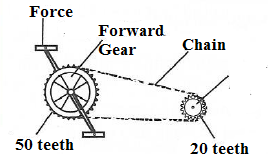
- Five
- Four
- Three
- one
- Many
11. The parts that make up the circulatory system are the blood itself,
- brain and blood vessels
- lungs and blood vessels
- heart and blood vessels
- heart and sensory nerves
- heart and brain
12. The weight of the load x in the following diagram is:
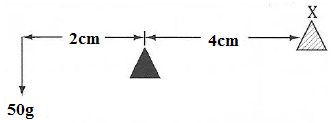
- 200 kg
- 2.5 kg
- 25 kg
- 250 kg
- 36.5 kg
13. The act of breaking down and changing food so that it can be absorbed in the body is known as
- digestion
- fertilization
- absorption
- excretion
- respiration
14. Observe the following diagram carefully. Whose particles are more loosely packed?
|
|
15. Which of the following diseases is caused by vitamin deficiency?
- Tuberculosis
- scurvy
- Chickenpox
- Malaria
- Diarrhea
16. Magnetism can be removed by doing the following:
- Hitting and heating while hanged east-westwards
- Hanging East-Westwards and washing it
- Coiling it and then allowing an electric current to pass through it
- Coiling it and then burning it
- Hitting it and then coiling it
17. Fishing with dynamite fishing is one way to:
- promoting science
- ways of killing water hyacinth that litter the water
- destroying fish stocks and polluting the environment
- removing large fish species
- to chase away wild sharks from eating small fish
18. The part shown with the letter Z in the following diagram is called
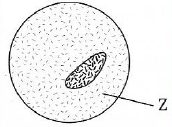
- nucleus
- vacuole
- cytoplasm
- cell wall
- epithelium
19. Which of the following diseases can be prevented by vaccination?
- Whooping cough
- Gonorrhea
- Malaria
- typhoid
- Cholera
20. Which of the following acts promotes soil erosion?
- Raising a lot of livestock and cutting down trees
- terracing farming and grass spreading
- non-terracing and irrigation
- Raising a lot of livestock and planting trees
- Planting trees and burning fields
21. Seed dispersed by animals are characterized by:
- having thorns
- being light
- having a hard shell
- being heavy
- they are easily portable
22. Examine the following diagram carefully. What are the results?
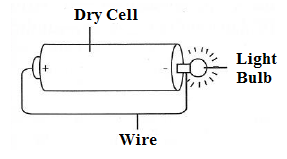
- The light bulb will give out light
- The light bulb will not give out light
- The cell does not work
- The light bulb will burst
- The light bulb will get burnt
23. Which in the following parts of the blood fights germs?
- Red blood cells
- Platelet cells
- white blood cells
- Water
- proteins
24. Which is the correct ecosystem?
- Leaves → termites → man→ chickens
- Leaves → termites → chicken→ man
- Termites → leaves → chicken → man
- Chicken → man → leaves → termites
- Man → leaves → chicken → termites
25. The following symbol represents ![]()
- resistance
- light bulb
- galvanometer
- ammeter
- cell
26. How can AIDS be spread in the following areas?
- Holding hands with an affected person
- Sharing toilets and bathrooms with an affected person
- sexual intercourse
- Swimming together with an affected person
- Insect bites such as mosquitoes or tsetse flies
27. Carefully examine the following diagram. The function of the section indicated by the letter M is:
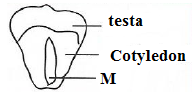
- to protect the seed from pests
- germinate and become a stem(shoot)
- food storage for seedlings sprouting
- water storage
- absorbing food from soil
28. Which of the following disease are hereditary?
- Measles and asthma
- Albinism and sickle cell anemia
- Diabetes and elephantiasis
- chickenpox and sickle cell anemia
- Albinism and rickets
29. The key steps in conducting scientific research are: (i) data collection; (ii) conducting an experiment; (iii) translating data; (iv) identify the problem; (v) analyze data. Which series is correct?
- (i) → (iv) → (v) → (iii) → (ii)
- (iii) → (iv) → (i) → (v) → (ii)
- (iv) → (ii) → (i) → (v) → (iii)
- (iii) → (iv) → (ii) → (i) → (v)
- (ii) → (iii) → (iv) → (i) → (v)
30. Bahati prepared the experiment as shown in the following diagram. He heated the flask and then poured hot water on it. What will happen to the level of water in the tube?
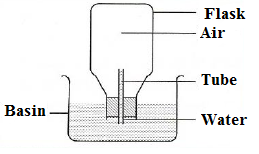
- It will go down
- It will rise
- It will remain the same
- It will start to boil
- It will start to evaporate
31. The light ray bends when:
- It travels in the same medium
- Travels from one medium to another
- water
- glass
- air
32. One of the effects of industrialization on the global environment is:
- increased employment
- increased sales products
- increased production expertise
- increased temperature
- increased economic benefits
33. One of the excretory organs is:
- nose
- intestine
- skin
- fingernails
- skin hairs
34. The origin of all energy sources on earth is:
- the sun
- the moon
- plants
- animals
- water
35. Desert plants have thin needles like leaves. This helps them to:
- the plant grows fast
- prevent plant from being eaten by animals
- water storage
- simplify photosynthesis
- easily get sunlight
36. The test report layout consists of five main parts which are 1. Aim, 2. Results 3. Materials 4. Conclusions 5. Methods. Which series is right for a good report?
- 1 → 3 → 5 → 2 → 4
- 3 → 2 → 4 → 1 → 5
- 4 → 3 → 1 → 5 → 2
- 2 → 1 → 5 → 4 → 3
- 5 → 1 → 3 → 2 → 4
37. The largest planet is.........
- Satan
- Uranus
- Jupiter
- Neptune
- Earth
38. The three main parts of the pistil are
- ovary, style and filament
- stigma, style and anther
- stigma, style and ovary
- ovary, stigma and filament
- style, filament and stigma
39. We are advised to refer children to clinics for immunizations against:
- Measles, malaria, anemia and HIV/AIDS
- Whooping cough, diphtheria, HIV/AIDS and malaria
- Measles, diphtheria, and whooping cough
- Diphtheria, anemia, cholera, and meningitis
- Cholera, malaria, measles, and HIV/AIDS
40. In order for a plant to undergo photosynthesis during the day it needs air of:
- oxygen
- nitrogen
- ozone
- hydrogen
- carbon dioxide
41. The only way to protect ourselves against trachoma is:
- eat foods rich in vitamin A
- eat starchy foods
- washing hands with clean water
- wear sunglasses
- regular eye check ups
42. In conducting scientific experiments, when do we formulate a law?
- Conclusion
- The result
- hypothesis
- apparatus
- aim
43. The following diagram shows
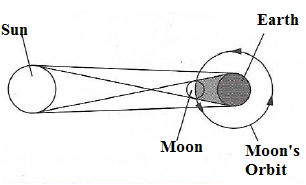
- solar eclipse
- seasons of the year
- solar system
- lunar eclipse
- day and night
44. One of the characteristics of living organisms includes reproduction. Other characteristics are:
- sensitivity and hearing
- movement and hearing
- respiration and movement
- seeing and growth
- hearing and seeing
45. The part shown by letter B in the digestive system of the following diagram secrets the acid of:
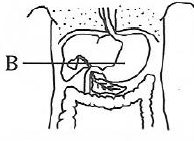
- nitric
- citric
- acetic
- hydrochloric acid
- sulphuric
SCIENCE 2005
Choose the correct answer and write the letter in the correct column for each question in the answer sheet.
1. Listed below are parts of the human eye except
- ciliary
- retina
- pupil
- shutter
- iris
2. The transportation of food in the body is done by:
- blood
- water
- air
- muscles
- nerves
3. Chemicals used to determine whether certain food is of the type of starch is:
- base
- alcohol
- acid
- alkali
- iodine
4. The vacuum in the tea bottle (Figure 1) prevents heat loss through:
|
|
| Figure No. 1 |
- reflection
- conduction and radiation
- convection and conduction
- radiation
- convection and radiation
5. Actual imagery is made of objects that have the character of:
- sending light to the object
- collecting light
- spreading light
- allowing light to penetrate
- preventing refraction of light
6. Tsetse flies cause a disease called
- elephantiasis
- measles
- cholera
- sleeping sickness
- malaria
7. Temporary hard dry water can be changed into soft water by
- boiling
- fitting
- distilling
- freezing
- heating
8. The disease-causing organism shown in Figure 2 is called
|
|
| Figure No. 2 |
- bacteria
- plasmodium
- virus
- amoeba
- fungi
9. The magnetic field is the area
- on a magnet
- where magnet force is experienced
- showing north and south poles of a magnet
- where the magnetic force moves from north to south
10. During the dry season the trees shed their leaves:
- to allow new leaves to grow
- because they are old
- to increase soil fertility
- to allow the growth of new flowers
- to prevent water loss
11. High blood pressure is caused by:
- fats
- arteries enlargement
- rupturing of veins
- pressed veins
- enlargement of the veins
12. It is important to take the following precautions during war except:
- clearing the environment by cutting down trees
- building strong houses
- food storage
- preparing trenches
- moving elsewhere
13. A balanced diet is one with the following combinations:
- cassava, beans, eggs, milk and fruit
- fruit, eggs, rice, groundnuts and meat
- bread, spinach, cowpies, groundnuts and fruit
- maize, eggs, fish, rice and fruit
- spinach, groundnuts, eggs, beans and fruit.
14. Planets differ from stars because planets:
- do not rotate around the sun
- are in gaseous state
- have moons that rotate around them
- have natural light
- are bigger than stars
15. To balance the metre ruler shown in figure 3 the mass of P must be………..g.
|
|
| Figure 3 |
- 46
- 16
- 10
- 40
- 24
16. People who exercise should eat foods that are high in:
- protein
- carbohydrates
- vitamin D
- vitamin C
- minerals
17. The letter J in Figure 4 represents a vein taking blood from the heart called:
|
|
| Figure No. 4 |
- vena cava
- auricle
- ventricle
- vena
- aorta
18. A block and tackle system make it easier to work because:
- most of the force comes from the machine itself
- increases half of the load-carrying capacity
- helps to change the direction of force
- many strings increase friction
- the load is tied at one end of the string
19. On hot days, it is not advisable to wear black because the clothes:
- reflects light
- protects against heat
- reflect heat
- absorbs heat
- refracts light.
20. An electrical object that changes alternating current into direct current is called:
- rectifier
- transistor
- amplifier
- resistor
- transformer
21. . . . . . . . . is a disease caused by malnutrition:
- Dysentery
- marasmus
- AIDS
- Cholera
- Leprosy
22. To prevent anemia, a pregnant woman is advised to eat foods that contain:
- starch
- fats
- mineral and salts
- sugar
- protein
23. The plane shown in Figure 5 can fly if a lifting force will be greater than gravitational force and will be greater than
|
|
| Figure No. 5 |
- opposing force
- moving force
- pulling force
- mass of the aeroplane
- acceleration
24- The following ingredients are used to add flavor and aroma to food:
- pepper, eggplant and curry
- curry, pepper and okra
- cloves, curry and okra
- eggplant, cloves and peppers
- curry, pepper and cloves
25. Oxygenated blood circulates from ... .... ..... to all parts of the body:
- kidney
- heart
- vessels
- liver
- lungs
26. In Figure 6, the letter S represents
|
|
| Figure No. 6 |
- ovary
- ureter
- bladder
- teste
- kidney
27. The quality of porcelain minerals is:
- shine
- harder than other minerals
- to be unstable
- sticking
- having a yellow color
28. The key steps to go about making a magnet using a nail and a single magnet are:
- scratching the nail towards both sides
- to magnetize a nail
- rearranging the atoms of the nail
- wrapping an electric wire around the nail
- scratching the nail in one direction
29. The brightest star in the southern sky is called:
- Alpha centaury
- Cassiop eia
- Little dipper
- Big dipper
- Gemini
30. Biogas is a special gas derived from a mixture of:
- carbon dioxide, methane and oxygen
- methane, water vapor and carbon dioxide
- water vapor, hydrogen and oxygen
- methane, oxygen and nitrogen
- oxygen, carbon dioxide and nitrogen
31. One of the functions of solar energy panels is:
- burning waste paper
- calculating sums
- boiling water
- generating electricity
- freezing water
32. The simplest way to determine the volume of irregular objects is to use the object itself, the eureka can:
- circular flask with water
- water and bottles
- glasses and water
- water and measuring cylinder
- scales and water
33. The ovary in Figure 7 is represented by the letters:
|
|
| Figure No. 7 |
- P
- Q
- R
- S
- T
34. When a baby is born it can do the following:
- crying, sucking breast milk and inhaling air
- sucking breast milk, laughing and crying
- inhale, see and laugh
- hearing, inhalation and smell
- smiling, hearing and crying
35. One of the benefits of insects flying from one flower to another is
- reporting rainfall
- give off a pleasant aroma
- pollinating flowers
- to beautify the environment
- making honey
36. When a person walks, he/she does not slip and fall easily because of force:
- gravitational
- electricity
- heat
- friction
- chemicals
37. The arrangement of the magnetic fields shown in Figure 8 occurs when:
|
|
| Figure No. 8 |
- the southern and northern extremities are facing each other
- the southern and southern ends are facing each other
- When a circular-shaped magnet faces a U-shaped magnet
- When a U-shaped magnet collides with a Fig. 8 heap.
- the north and north ends are facing.
38. The following sections perform the same function of storing human reproductive gametes:
- fallopian tubes and sperm duct tubes
- penis and vagina
- testicles and uterus
- ovaries and penis
- ovaries and testicles
39. Sound cannot travel in:
- water
- vacuum
- solid matter
- air
- glass
40. In Figure 9 the amount of resistance in R2 after closure of the switch is 0hms .........
|
|
| Figure No. 9 |
- 6.4
- 4.5
- 6.0
- 2.0
- 8.0
41. Weaknesses in science lie in the failure to prove:
- the presence of the sun
- the earth revolves around the sun
- some superstitions
- problems arising from superstition
- modern technology
42. NPK Fertilizer is a mixture of:
- nitrogen, phosphorus and calcium
- nitrogen, sulphur and phosphorus
- phosphorus, sulphur and nitrate
- nitrogen, potassium and phosphorus
- nitrogen, potassium and calcium
43. Measles disease is spread by:
- flies
- injection
- touching
- mosquitoes
- air
44. The type of soil that penetrates water more easily and quickly is
- loan
- humus
- sand
- clay
- mixed soil.
45. A chemical used to kill germs in drinking water is called
- chlorine
- calcium
- fluorine
- carbon dioxide
- iodine
VIEW MARKING SCHEME

Hub App
 For Call,Sms&WhatsApp: 255769929722 / 255754805256
For Call,Sms&WhatsApp: 255769929722 / 255754805256
 For Call,Sms&WhatsApp: 255769929722 / 255754805256
For Call,Sms&WhatsApp: 255769929722 / 255754805256
WHATSAPP US NOW FOR ANY QUERY
App Ya Learning Hub Tanzania





